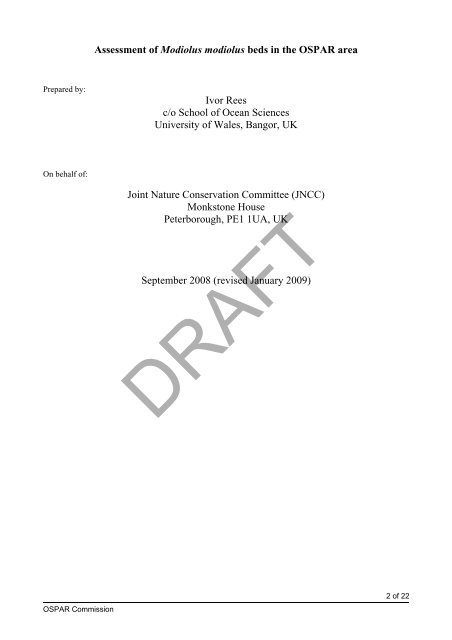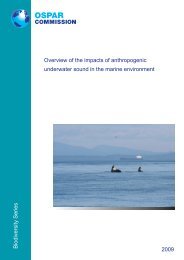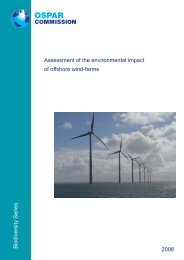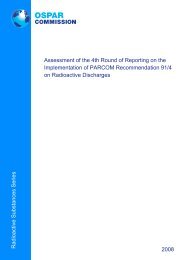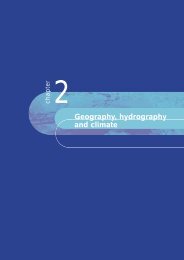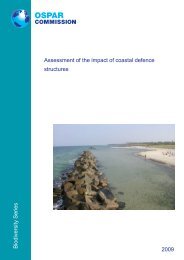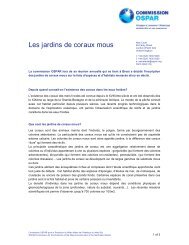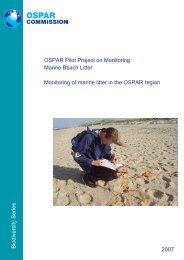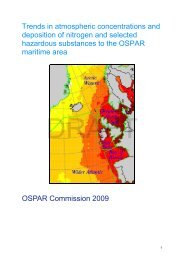Assessment of Modiolus modiolus beds in the OSPAR area Ivor ...
Assessment of Modiolus modiolus beds in the OSPAR area Ivor ...
Assessment of Modiolus modiolus beds in the OSPAR area Ivor ...
Create successful ePaper yourself
Turn your PDF publications into a flip-book with our unique Google optimized e-Paper software.
Prepared by:<br />
On behalf <strong>of</strong>:<br />
<strong>OSPAR</strong> Commission<br />
<strong>Assessment</strong> <strong>of</strong> <strong>Modiolus</strong> <strong>modiolus</strong> <strong>beds</strong> <strong>in</strong> <strong>the</strong> <strong>OSPAR</strong> <strong>area</strong><br />
<strong>Ivor</strong> Rees<br />
c/o School <strong>of</strong> Ocean Sciences<br />
University <strong>of</strong> Wales, Bangor, UK<br />
Jo<strong>in</strong>t Nature Conservation Committee (JNCC)<br />
Monkstone House<br />
Peterborough, PE1 1UA, UK<br />
September 2008 (revised January 2009)<br />
DRAFT<br />
2<strong>of</strong> 22
<strong>OSPAR</strong> Background Document for <strong>Modiolus</strong> <strong>modiolus</strong> <strong>beds</strong><br />
1. Background Information<br />
1.1 Name <strong>of</strong> habitat<br />
<strong>Modiolus</strong> <strong>modiolus</strong> bed<br />
1.2 Def<strong>in</strong>ition <strong>of</strong> habitat<br />
The horse mussel <strong>Modiolus</strong> <strong>modiolus</strong> forms dense <strong>beds</strong>, at depths up to 70m (but may extend onto <strong>the</strong> lower<br />
shore), mostly <strong>in</strong> fully sal<strong>in</strong>e conditions and <strong>of</strong>ten <strong>in</strong> tide-swept <strong>area</strong>s. Although M. <strong>modiolus</strong> is a widespread<br />
and common species, horse mussel <strong>beds</strong> (with typically 30% cover or more) are more limited <strong>in</strong> <strong>the</strong>ir<br />
distribution. <strong>Modiolus</strong> <strong>beds</strong> are found on a range <strong>of</strong> substrata, from cobbles through to muddy gravels and<br />
sands, where <strong>the</strong>y tend to have a stabilis<strong>in</strong>g effect, due to <strong>the</strong> production <strong>of</strong> byssal threads. Communities<br />
associated with <strong>Modiolus</strong> <strong>beds</strong> are diverse, with a wide range <strong>of</strong> epibiota and <strong>in</strong>fauna be<strong>in</strong>g recorded,<br />
<strong>in</strong>clud<strong>in</strong>g hydroids, red seaweeds, solitary ascidians and bivalves such as Aequipecten opercularis and<br />
Chlamys varia. As M. <strong>modiolus</strong> is an Arctic-Boreal species, its distribution ranges from <strong>the</strong> seas around<br />
Scand<strong>in</strong>avia (<strong>in</strong>clud<strong>in</strong>g Skagerrak & Kattegat) and Iceland south to <strong>the</strong> Bay <strong>of</strong> Biscay.<br />
1.3 Correlation with habitat classification schemes<br />
The <strong>OSPAR</strong> priority habitat type <strong>in</strong>cludes four <strong>Modiolus</strong> bed habitat types, as def<strong>in</strong>ed <strong>in</strong> both <strong>the</strong> European<br />
EUNIS habitat classification (2007 version; http://eunis.eea.europa.eu/habitats.jsp) and <strong>the</strong> National Mar<strong>in</strong>e<br />
Habitat Classification for Brita<strong>in</strong> and Ireland (Connor et al., 2004). These are:<br />
EUNIS Code: A5.621, A5.622, A5.623 and A5.624<br />
National Mar<strong>in</strong>e Habitat Classification for UK & Ireland code: SS.SBR.SMus.ModT,<br />
SS.SBR.SMus.ModMx, SS.SBR.SMus.ModHAs and SS.SBR.SMus.ModCvar<br />
The EUNIS classification descriptions are derived largely from records <strong>of</strong> associated epibiota <strong>in</strong> UK waters,<br />
Revisions may be needed to account for different species occurr<strong>in</strong>g amongst <strong>Modiolus</strong> <strong>beds</strong> <strong>in</strong> nor<strong>the</strong>rly<br />
biogeographic regions (e.g. Iceland, F<strong>in</strong>mark Coast and White Sea).<br />
A topographic classification could also be useful for describ<strong>in</strong>g features <strong>of</strong> <strong>the</strong> <strong>beds</strong>, bear<strong>in</strong>g <strong>in</strong> m<strong>in</strong>d that<br />
extensive surveys <strong>of</strong> <strong>beds</strong> will rely more on sonar methods supplemented by visual record<strong>in</strong>g to provide<br />
ground-truth <strong>in</strong>formation. For example, <strong>the</strong> mussels can be <strong>in</strong> isolated clumps, <strong>in</strong> ribbon-like reefs with<br />
superimposed wave-like undulations or <strong>in</strong> sheets.<br />
<strong>OSPAR</strong> Commission<br />
DRAFT<br />
1.4 Common characteristics <strong>of</strong> <strong>the</strong> habitat<br />
M. <strong>modiolus</strong> forms “<strong>beds</strong>” (biogenic reefs) on <strong>the</strong> seabed where dense populations <strong>of</strong> <strong>the</strong>se large bivalves<br />
occur (Holt, et al, 1998). Individuals can grow to lengths >150mm and can live for >45 years (Anwar, et al,<br />
1990). The mussels attach to <strong>the</strong> substratum and to each o<strong>the</strong>r with byssal threads so that <strong>the</strong>y aggregate <strong>in</strong>to<br />
clumps. They can cover much <strong>of</strong> <strong>the</strong> underly<strong>in</strong>g seabed to create a dist<strong>in</strong>ctive biogenic habitat. Gradations<br />
occur from isolated <strong>in</strong>dividuals, which may nest <strong>in</strong> <strong>the</strong> sediment, through well-scattered small clumps to near<br />
total coverage <strong>of</strong> <strong>the</strong> seabed. Patches extend<strong>in</strong>g over >10m 2 with >30% cover by mussels should def<strong>in</strong>itely<br />
be classified as “bed”. However, mosaics also occur where frequent smaller clumps <strong>of</strong> mussels so <strong>in</strong>fluence<br />
ecosystem function<strong>in</strong>g that for conservation and management purposes lower thresholds can be accepted.<br />
Scattered populations <strong>of</strong> isolated full-grown <strong>in</strong>dividuals or <strong>of</strong> spat at quite high densities are not classified<br />
here as “<strong>beds</strong>”.<br />
M. <strong>modiolus</strong> is a widespread and common Pan-Boreal species (Tebble, 1966; Poppe & Goto, 1993), but<br />
“<strong>beds</strong>” are much more limited <strong>in</strong> <strong>the</strong>ir distribution becom<strong>in</strong>g absent or scarce towards <strong>the</strong> geographic range<br />
limits <strong>of</strong> <strong>the</strong> species. The aggregations <strong>of</strong> M. <strong>modiolus</strong> which form <strong>beds</strong> typically occur at depths from <strong>the</strong><br />
lower shore (Davenport & Kjorsvik, 1982) to about 70m but clumps <strong>of</strong> <strong>the</strong>m have been found below 100m <strong>in</strong><br />
<strong>the</strong> Irish Sea. Off <strong>the</strong> Faeroes <strong>the</strong>y occur to about 200m depth, be<strong>in</strong>g densest at 65-95m (Tendal & D<strong>in</strong>esen,<br />
2005), Mostly <strong>the</strong> <strong>beds</strong> are <strong>in</strong> current-swept fully-sal<strong>in</strong>e locations, although some can be found <strong>in</strong> sheltered<br />
3<strong>of</strong> 22
ays, fjords or lochs, with some <strong>beds</strong> restricted to depths below halocl<strong>in</strong>es. <strong>Modiolus</strong> <strong>beds</strong> occur on a range<br />
<strong>of</strong> substrata, most <strong>of</strong>ten on cobbles through to muddy gravels <strong>of</strong> glacigenic or glaciomar<strong>in</strong>e orig<strong>in</strong>, but have<br />
also been found on bedrock. They can also colonise <strong>the</strong> legs <strong>of</strong> <strong>of</strong>fshore structures (Anwar et al, 1990). Beds<br />
are <strong>of</strong>ten persistent features which build up through accumulat<strong>in</strong>g faecal pellets, shell and trapped sand, so<br />
that <strong>the</strong>y may become de-coupled from <strong>the</strong> substratum on which <strong>the</strong>y were orig<strong>in</strong>ally founded. They can be<br />
self-susta<strong>in</strong><strong>in</strong>g to <strong>the</strong> extent that spat survival is greatest <strong>in</strong> <strong>the</strong> crevices amongst <strong>the</strong> byssal threads <strong>of</strong> <strong>the</strong><br />
mature clumps. Predation by crabs and starfish is high while <strong>in</strong>dividuals are small, so <strong>the</strong> demographic<br />
pattern allows for rapid somatic growth for <strong>the</strong> first few years followed by longevity at slower growth rates.<br />
Growth, longevity and maximum sizes vary with environmental stresses <strong>in</strong> different localities (Anwar et al,<br />
1990).<br />
The mussels have a stabilis<strong>in</strong>g effect on <strong>the</strong> seabed, due to b<strong>in</strong>d<strong>in</strong>g by <strong>the</strong> byssal threads; thus <strong>beds</strong> can alter<br />
sea floor roughness, topography and acoustic reflectivity. The composition <strong>of</strong> <strong>the</strong> sediment <strong>in</strong> and under <strong>the</strong><br />
mussel clumps also differs. Individual M. <strong>modiolus</strong> most <strong>of</strong>ten live partly buried <strong>in</strong> <strong>the</strong> sediment (Meadows<br />
& Shand, 1989). Substantial accumulations <strong>of</strong> dead shell <strong>of</strong>ten occur <strong>in</strong> and around <strong>the</strong> long established <strong>beds</strong>.<br />
Associated with <strong>Modiolus</strong> <strong>beds</strong> are diverse ranges <strong>of</strong> epibiota attached to <strong>the</strong> mussels and to <strong>the</strong> stabilised<br />
gravel. Foliose and encrust<strong>in</strong>g calcareous red algae grow on <strong>the</strong>m where parts <strong>of</strong> <strong>the</strong> <strong>beds</strong> are with<strong>in</strong> photic<br />
depths. In <strong>the</strong> shallow sublittoral zone <strong>the</strong>y may provide attachment for kelp. The relative proportions <strong>of</strong> s<strong>of</strong>t<br />
epibiota (sponges, hydroids and s<strong>of</strong>t corals) compared to hard epibiota (serpulid polychaetes, barnacles and<br />
saddle oysters) varies. These differences are ma<strong>in</strong>ly due to current stress act<strong>in</strong>g through abrasion by sand and<br />
shell fragments carried as bed load. Infauna, supported through pelagic-benthic coupl<strong>in</strong>g by <strong>the</strong>se filter<br />
feeders (Navarro & Thompson, 1997; Wildish & Fader, 1998), is enhanced and <strong>the</strong>re are niches for higher<br />
numbers <strong>of</strong> crevice-liv<strong>in</strong>g species, predators and scavengers (Rees, et al, 2008). Fish make use <strong>of</strong> both <strong>the</strong><br />
higher production <strong>of</strong> benthic prey and <strong>the</strong> added structural complexity. Several commercially exploited<br />
scallop species (Pecten maximus, Aequipecten opercularis and Chlamys islandica) occur <strong>in</strong> <strong>the</strong> same habitat<br />
and may as spat have been attached to <strong>the</strong> hydroids grow<strong>in</strong>g on <strong>the</strong> mussels.<br />
2. Orig<strong>in</strong>al evaluation aga<strong>in</strong>st <strong>the</strong> Texel-Faial selection criteria<br />
2.1 <strong>OSPAR</strong> Regions and biogeographic zones where <strong>the</strong> feature occurs<br />
<strong>Modiolus</strong> <strong>beds</strong> occur <strong>in</strong> <strong>OSPAR</strong> Regions I, II, III (<strong>the</strong> records <strong>in</strong> Region IV need confirmation).<br />
By D<strong>in</strong>ter (2001) biogeographic zones, <strong>Modiolus</strong> <strong>beds</strong> are found <strong>in</strong>:-<br />
Barents Sea (sou<strong>the</strong>rn parts)<br />
White Sea<br />
F<strong>in</strong>mark Coast<br />
Norwegian Coast – W. Norway<br />
Norwegian Coast - Skaggerak<br />
South Iceland – Faeroe Shelf<br />
Boreal<br />
Boreal-Lusitanean (far nor<strong>the</strong>rn part)<br />
<strong>OSPAR</strong> Commission<br />
DRAFT<br />
2.2. <strong>OSPAR</strong> Regions and biogeographic zones where <strong>the</strong> feature is under threat and/or <strong>in</strong> decl<strong>in</strong>e<br />
<strong>OSPAR</strong> Regions: I, II, III. The scale <strong>of</strong> threats and <strong>the</strong> strength <strong>of</strong> available evidence varies between regions<br />
and <strong>the</strong> waters <strong>of</strong> Contract<strong>in</strong>g Parties.<br />
<strong>Modiolus</strong> <strong>beds</strong> are vulnerable <strong>in</strong> most <strong>of</strong> <strong>the</strong> D<strong>in</strong>ter biogeographic zones where <strong>the</strong>y currently occur, but<br />
evidence for decl<strong>in</strong>e is <strong>in</strong>sufficient <strong>in</strong> some zones.<br />
2.3. Evaluation aga<strong>in</strong>st <strong>the</strong> Texel-Faial criteria for which <strong>the</strong> feature was put on <strong>the</strong> <strong>OSPAR</strong> List<br />
The nom<strong>in</strong>ation <strong>of</strong> <strong>Modiolus</strong>.<strong>modiolus</strong> <strong>beds</strong> to be placed on <strong>the</strong> <strong>OSPAR</strong> List was on <strong>the</strong> basis <strong>of</strong> an<br />
evaluation <strong>of</strong> <strong>the</strong>ir status accord<strong>in</strong>g to <strong>the</strong> Texel-Faial Criteria (<strong>OSPAR</strong> 2003). The citation noted <strong>the</strong><br />
sensitivity, particularly to physical disturbance, <strong>of</strong> this biogenic habitat and it’s low resilience which results<br />
from <strong>the</strong> long life span <strong>of</strong> <strong>in</strong>dividuals coupled with erratic recruitment, that is most successful amongst pre-<br />
4<strong>of</strong> 22
exist<strong>in</strong>g <strong>beds</strong>,. The ecological significance <strong>of</strong> <strong>the</strong> biogenic habitat and evidence for significant decl<strong>in</strong>es or<br />
degradation at several locations where <strong>the</strong>re have been detailed studies.<br />
See Annex 3 for a detailed evaluation aga<strong>in</strong>st <strong>the</strong> Texel-Faial criteria.<br />
3. Current status <strong>of</strong> <strong>the</strong> habitat<br />
3.1 Distribution <strong>in</strong> <strong>OSPAR</strong> Region<br />
<strong>Modiolus</strong> <strong>modiolus</strong> <strong>beds</strong> occur patchily and ma<strong>in</strong>ly <strong>in</strong> cold temperate coastal parts <strong>of</strong> <strong>the</strong> north-east Atlantic<br />
shelf seas, from sou<strong>the</strong>rn parts <strong>of</strong> <strong>the</strong> Barents Sea and <strong>the</strong> White Sea to <strong>the</strong> sou<strong>the</strong>rn North Sea and <strong>the</strong><br />
sou<strong>the</strong>rn Irish Sea. Beds also occur around <strong>the</strong> Atlantic islands <strong>of</strong> Iceland and <strong>the</strong> Faeroes. The species is<br />
currently absent <strong>in</strong> Arctic waters at Svalbard and East Greenland although it did occur at Svalbard dur<strong>in</strong>g <strong>the</strong><br />
Holocene climate optimum 8700-7700 BP (Salvigsen et al, 2007). The sou<strong>the</strong>rn end <strong>of</strong> <strong>the</strong> biogeographic<br />
range <strong>of</strong> <strong>Modiolus</strong> <strong>modiolus</strong> extends at least to <strong>the</strong> Bay <strong>of</strong> Biscay (Poppe & Goto, 1993) but it is not known<br />
to form <strong>beds</strong> beyond <strong>the</strong> North Sea and <strong>the</strong> sou<strong>the</strong>rn Irish Sea. At <strong>the</strong> south <strong>of</strong> its range M. <strong>modiolus</strong> overlaps<br />
with <strong>Modiolus</strong> adriaticus; <strong>the</strong> later species does not seem to aggregate to form <strong>beds</strong>.<br />
The currently available data on distribution <strong>of</strong> <strong>the</strong> habitat <strong>in</strong> <strong>the</strong> <strong>OSPAR</strong> <strong>area</strong> (Figure 1) and <strong>the</strong> UK<br />
(Figure 2) does not fully concur with recent <strong>in</strong>formation from experts. The discrepancies are partly due to<br />
difficulties <strong>in</strong> dist<strong>in</strong>guish<strong>in</strong>g records <strong>of</strong> <strong>in</strong>dividual specimens from aggregations which are sufficient to be<br />
reliably classified as <strong>beds</strong>. An overview <strong>of</strong> distribution <strong>in</strong> <strong>the</strong> waters <strong>of</strong> <strong>OSPAR</strong> Contract<strong>in</strong>g Parties and <strong>the</strong><br />
Russian part <strong>of</strong> <strong>the</strong> <strong>OSPAR</strong> region is provided <strong>in</strong> Annex I.<br />
<strong>OSPAR</strong> Commission<br />
DRAFT<br />
Figure 1. Distribution <strong>of</strong> <strong>Modiolus</strong> <strong>modiolus</strong> <strong>beds</strong> <strong>in</strong> <strong>the</strong> <strong>OSPAR</strong> <strong>area</strong>, based on data supplied by Contract<strong>in</strong>g<br />
Parties to December 2008 (annotations by <strong>Ivor</strong> Rees, September 2008, updated by JNCC <strong>in</strong> January 2009). 1<br />
1 The coastl<strong>in</strong>e and bathymetry are derived from <strong>the</strong> GEBCO digital atlas. The map is projected <strong>in</strong> <strong>the</strong> North Pole Lambert Azimuthal Equal Area<br />
projection (Central Meridian 0.000000, Latitude <strong>of</strong> orig<strong>in</strong> 90.000000).<br />
5<strong>of</strong> 22
Figure 2. Distribution <strong>of</strong> <strong>Modiolus</strong> <strong>modiolus</strong> <strong>beds</strong> <strong>in</strong> UK waters, based on data supplied by Contract<strong>in</strong>g<br />
Parties to December 2008 (annotations by <strong>Ivor</strong> Rees, September 2008, updated by JNCC January 2009). 2<br />
3.2 Habitat extent and environmental factors<br />
The total extent <strong>of</strong> <strong>Modiolus</strong> <strong>beds</strong> <strong>in</strong> <strong>the</strong> <strong>OSPAR</strong> <strong>area</strong> is unknown. Indeed <strong>the</strong>re is relatively limited<br />
<strong>in</strong>formation on habitat extent with<strong>in</strong> Contract<strong>in</strong>g Parties, although this is improv<strong>in</strong>g (e.g. through MESH <strong>in</strong><br />
<strong>the</strong> UK; www.searchMESH.net).<br />
<strong>OSPAR</strong> Commission<br />
DRAFT<br />
Individual <strong>Modiolus</strong> <strong>beds</strong> usually extend over only a few square kilometres and <strong>of</strong>ten <strong>the</strong> <strong>area</strong> <strong>of</strong> a bed<br />
measures only a few hectares or less. Several semi-discrete <strong>beds</strong> may occur with<strong>in</strong> a limited <strong>area</strong>. Some <strong>of</strong><br />
<strong>the</strong> <strong>beds</strong> have sufficiently dist<strong>in</strong>ct borders, which show up us<strong>in</strong>g acoustic survey methods, so <strong>the</strong>ir extent can<br />
be measured accurately (L<strong>in</strong>denbaum, et al, 2008). In o<strong>the</strong>r cases <strong>the</strong>re are gradations from obvious biogenic<br />
reef, to patchy ribbons, to <strong>area</strong>s with frequent substantial clumps and <strong>the</strong>n to sparsely-distributed small<br />
clumps. Beds that may have once had discrete edges will <strong>of</strong>ten show open tracks through <strong>the</strong>m and be<br />
degraded to patchy clumps at <strong>the</strong> marg<strong>in</strong>s after disturbance by towed fish<strong>in</strong>g gear. Bed extent is <strong>the</strong>n open to<br />
differ<strong>in</strong>g <strong>in</strong>terpretations.<br />
Beds have been found <strong>in</strong> a wide range <strong>of</strong> situations from <strong>the</strong> lower shore to nearly 200m depth and on a wide<br />
range <strong>of</strong> substrata from bed rock to cohesive mud. Most commonly <strong>the</strong>y are <strong>in</strong> full sal<strong>in</strong>ity and on mixed<br />
coarse sediments <strong>of</strong> glacigenic or glaciomar<strong>in</strong>e orig<strong>in</strong>. Environmental conditions associated with particular<br />
<strong>beds</strong> are <strong>of</strong>ten localised so it is difficult to def<strong>in</strong>e <strong>the</strong> ecological limits. Local situations <strong>in</strong>clude places where<br />
currents are stronger over sills at <strong>the</strong> mouths <strong>of</strong> fjords or lochs and <strong>in</strong> channels between islands. Computeraided<br />
prediction, us<strong>in</strong>g GIS methods to overlay multiple physical and chemical factors, has been fairly<br />
successful for predict<strong>in</strong>g sediment habitats. However, forecast<strong>in</strong>g precisely where particular biogenic reefs<br />
2 The coastl<strong>in</strong>e and bathymetry are derived from <strong>the</strong> GEBCO digital atlas. The map is projected <strong>in</strong> <strong>the</strong> North Pole Lambert Azimuthal Equal Area<br />
projection (Central Meridian 0.000000, Latitude <strong>of</strong> orig<strong>in</strong> 90.000000).<br />
6<strong>of</strong> 22
should occur is less practicable due to <strong>the</strong> complex <strong>of</strong> biological feedback loops <strong>in</strong>volved. Some <strong>Modiolus</strong><br />
<strong>beds</strong> have probably existed at or near <strong>the</strong> same locations for so long that <strong>the</strong>y may have orig<strong>in</strong>ally developed<br />
when environmental conditions were different from today and might be regarded as relicts. In situations<br />
where isostatic rebound has altered depths and local current flows <strong>beds</strong> may persist <strong>in</strong> sub-optimal<br />
conditions.<br />
3.3 Condition (current/trends/future prospects)<br />
The condition <strong>of</strong> <strong>Modiolus</strong> <strong>beds</strong> may be judged <strong>in</strong> several different ways:-<br />
• Spatial <strong>in</strong>tegrity, such as whe<strong>the</strong>r fish<strong>in</strong>g gear tracks cut across a bed.<br />
• Topographic <strong>in</strong>tegrity, such as <strong>the</strong> cont<strong>in</strong>ued presence <strong>of</strong> ridges, mounds and o<strong>the</strong>r biogenic relief.<br />
• Size distributions <strong>of</strong> <strong>the</strong> mussels and whe<strong>the</strong>r <strong>the</strong> populations are be<strong>in</strong>g adequately renewed by<br />
successful spat settlement and juvenile survival through <strong>the</strong> first years when <strong>the</strong>y are most<br />
vulnerable to predation.<br />
• Abundance, composition, condition and diversity <strong>of</strong> <strong>the</strong> associated biota. For physical disturbance<br />
impacts, changes <strong>in</strong> s<strong>of</strong>t epifauna are more likely. Some <strong>of</strong> <strong>the</strong> vagile epifauna, such as brittlestars<br />
(e.g. Ophiothrix fragilis) are known to fluctuate markedly <strong>in</strong> abundance, so caution is needed when<br />
<strong>in</strong>terpret<strong>in</strong>g change. Damage also leads to <strong>in</strong>creased abundance <strong>of</strong> scavengers, which are attracted to<br />
disturbed <strong>area</strong>s.<br />
Only a few <strong>beds</strong> are known have been surveyed over long enough time spans for evidence <strong>of</strong> change to be<br />
apparent. In <strong>the</strong> Irish Sea, south <strong>of</strong> <strong>the</strong> Isle <strong>of</strong> Man, an extensive bed was almost completely lost due to<br />
scallop dredg<strong>in</strong>g (Veale et al, 2000). For similar reasons, <strong>beds</strong> <strong>in</strong> Strangford Lough (Nor<strong>the</strong>rn Ireland) also<br />
showed severe decl<strong>in</strong>es (Service & Magorrian 1997). Recently <strong>beds</strong> <strong>in</strong> North Anglesey (Wales) have been<br />
destroyed by fish<strong>in</strong>g activity (Holt 2008, Countryside Council for Wales, pers. comm.). By contrast, <strong>in</strong> an<br />
Icelandic bay <strong>Modiolus</strong> <strong>modiolus</strong> was still <strong>the</strong> dom<strong>in</strong>ant by-catch species <strong>in</strong> scallop dredges 30 years after<br />
scallop dredg<strong>in</strong>g began (Garcia & Ragnarsson, 2007). In Sullom Voe (Shetland) a bed co<strong>in</strong>cident with a<br />
pipel<strong>in</strong>e showed signs <strong>of</strong> recovery, with some re-colonisation <strong>of</strong> disturbed sediment after a few years (Mair<br />
et al, 2000). On <strong>the</strong> legs <strong>of</strong> an oil platform <strong>in</strong> <strong>the</strong> North Sea a substantial population was present 10 years<br />
after <strong>in</strong>stallation, but <strong>in</strong> this situation <strong>the</strong> young mussels would have been free <strong>of</strong> much predation (Anwar et<br />
al, 1990). As a species it appears to have decl<strong>in</strong>ed <strong>in</strong> <strong>the</strong> North Sea. Compar<strong>in</strong>g occurrences by ICES<br />
Rectangles Callaway et al (2007) showed that <strong>the</strong> species had been found <strong>in</strong> <strong>the</strong> 1982-85 period <strong>in</strong> 11<br />
rectangles, but comparable <strong>in</strong>ternational surveys <strong>in</strong> 2000 found it <strong>in</strong> only 1 rectangle.<br />
<strong>OSPAR</strong> Commission<br />
DRAFT<br />
Over large parts <strong>of</strong> <strong>the</strong> geographic range <strong>of</strong> this habitat <strong>the</strong>re is at present too little evidence to determ<strong>in</strong>e <strong>the</strong><br />
scale <strong>of</strong> anthropogenic impacts. There is clear evidence <strong>of</strong> fish<strong>in</strong>g impacts and anecdotal evidence for<br />
decl<strong>in</strong>es <strong>in</strong> quality <strong>in</strong> <strong>the</strong> Kattegat. Forecasts <strong>of</strong> change to 2020 depend most on developments <strong>in</strong> fisheries<br />
management, <strong>in</strong>clud<strong>in</strong>g <strong>the</strong> emphasis given to ecosystem-based management. Gear technology and<br />
navigation precision improvements will have <strong>in</strong>fluences as will relationships between fuel costs and landed<br />
values. In places, trends will also depend on <strong>in</strong>centives for <strong>in</strong>vestment <strong>in</strong> renewable energy <strong>in</strong>frastructure<br />
<strong>of</strong>fshore, particularly for tidal power. In <strong>the</strong> longer term it is likely that climate change will reduce <strong>beds</strong> <strong>in</strong><br />
<strong>the</strong> south but permit expansion <strong>in</strong> <strong>the</strong> far north (Hiscock et al, 2004). Ow<strong>in</strong>g to <strong>the</strong> long life-span <strong>of</strong> <strong>the</strong>se<br />
molluscs and <strong>the</strong> apparent persistence <strong>of</strong> established <strong>beds</strong> <strong>the</strong>re will be a considerable time-lag between<br />
climate shift and observable habitat changes. At present it is not possible to confidently discrim<strong>in</strong>ate climate<br />
change decl<strong>in</strong>es aga<strong>in</strong>st a background <strong>of</strong> fish<strong>in</strong>g impacts. Failures <strong>of</strong> recruitment or <strong>of</strong> <strong>the</strong> survival <strong>of</strong> young<br />
mussels through <strong>the</strong> period when <strong>the</strong>y are most vulnerable to predation are <strong>the</strong> most likely ways change will<br />
come about <strong>in</strong> <strong>the</strong> south. Hav<strong>in</strong>g shown an ability to colonise artificial habitats <strong>of</strong>fshore, it is likely that<br />
where suitable habitat exist, <strong>the</strong> species will be able to spread fur<strong>the</strong>r <strong>in</strong> <strong>the</strong> Arctic.<br />
3.4 Limitations <strong>in</strong> knowledge<br />
Partly as result <strong>of</strong> <strong>the</strong> patchy distribution <strong>of</strong> this biogenic habitat and uncerta<strong>in</strong>ty whe<strong>the</strong>r records refer to<br />
<strong>in</strong>dividuals or <strong>beds</strong>, detailed up-to-date distributional <strong>in</strong>formation is lack<strong>in</strong>g over significant parts <strong>of</strong> <strong>the</strong><br />
range. Without such <strong>in</strong>formation it is not possible to provide estimates <strong>of</strong> <strong>the</strong> <strong>area</strong> covered by <strong>the</strong> <strong>Modiolus</strong><br />
bed habitat or <strong>the</strong> proportion it makes up <strong>of</strong> <strong>the</strong> shelf seas <strong>in</strong> <strong>the</strong> whole <strong>OSPAR</strong> <strong>area</strong>.<br />
7<strong>of</strong> 22
The full range <strong>of</strong> variation <strong>in</strong> <strong>Modiolus</strong> biotopes is poorly documented, but it is certa<strong>in</strong>ly wider than implied<br />
by <strong>the</strong> present EUNIS classification. Differences <strong>in</strong> <strong>the</strong> sensitivity to various perturbations are not known.<br />
Bear<strong>in</strong>g <strong>in</strong> m<strong>in</strong>d <strong>the</strong> longevity <strong>of</strong> <strong>the</strong> mussels and <strong>the</strong> small number <strong>of</strong> studies runn<strong>in</strong>g long enough to detect<br />
change, <strong>in</strong>ferences <strong>of</strong>ten have to be drawn by reference to earlier sampl<strong>in</strong>g for different purposes, where<br />
different sampl<strong>in</strong>g gears were used and positions were less accurately known.<br />
4. Evaluation <strong>of</strong> threats and impacts<br />
A summary <strong>of</strong> <strong>the</strong> key activities which can cause impacts to <strong>Modiolus</strong> <strong>modiolus</strong> <strong>beds</strong> is given <strong>in</strong> Table 1.<br />
Type <strong>of</strong><br />
impact<br />
Destruction<br />
or<br />
degradation<br />
through<br />
extensive<br />
physical<br />
impacts<br />
Habitat loss<br />
or<br />
degradation<br />
through site<br />
specific<br />
physical<br />
damage<br />
Pollution:<br />
terrestrial<br />
run-<strong>of</strong>f or<br />
organic<br />
overload<br />
Removal <strong>of</strong><br />
species<br />
(mussels)<br />
Non-native<br />
species<br />
<strong>OSPAR</strong> Commission<br />
Cause <strong>of</strong> threat Comment<br />
Dredge fisheries<br />
for scallops,<br />
beam and otter<br />
trawl<strong>in</strong>g<br />
Infrastructure<br />
development<br />
(dam<br />
construction,<br />
coastal<br />
development,<br />
oil & gas<br />
exploitation)<br />
Agriculture,<br />
forestry and<br />
aquaculture.<br />
Dump<strong>in</strong>g at sea<br />
<strong>of</strong> dredge spoil,<br />
pipe discharges<br />
<strong>of</strong> effluent or<br />
cool<strong>in</strong>g water<br />
Harvest<strong>in</strong>g <strong>of</strong><br />
mussels<br />
Introductions<br />
for aquaculture<br />
or <strong>in</strong>advertently<br />
A previously substantial bed south <strong>of</strong> <strong>the</strong> Isle <strong>of</strong> Man was elim<strong>in</strong>ated by<br />
<strong>in</strong>tensive dredg<strong>in</strong>g for scallops <strong>in</strong> <strong>the</strong> 1970s and 1980s. In Strangford Lough<br />
Nor<strong>the</strong>rn Ireland <strong>beds</strong> that used to cover extensive <strong>area</strong>s were reduced to<br />
isolated small clumps by trawl<strong>in</strong>g for scallops. With o<strong>the</strong>r biogenic features<br />
<strong>beds</strong> are damaged by towed fish<strong>in</strong>g (Jenn<strong>in</strong>gs & Kaiser, 1998).<br />
Infrastructure developments such as oil platform <strong>in</strong>stallation, temporary<br />
plac<strong>in</strong>g <strong>of</strong> exploratory rigs, burial <strong>of</strong> pipel<strong>in</strong>es and cables all cause local<br />
impacts. O<strong>the</strong>r site specific developments such as tidal energy barrages or<br />
major port dredg<strong>in</strong>g could have wider effects but would be subject to EIA.<br />
Potential effects where enclosed water bodies suffer temporary hypoxia <strong>in</strong><br />
bottom waters. Local effects around licensed dump<strong>in</strong>g grounds, some<br />
wrecks, and effluent pipes. Effects <strong>of</strong> discharges are <strong>of</strong>ten mitigated by EIA<br />
and controls.<br />
Take for both human consumption and bait is thought to be small. Some<br />
<strong>Modiolus</strong> <strong>beds</strong> can have Mytilus edulis seed settl<strong>in</strong>g on <strong>the</strong>m and may have<br />
DRAFT<br />
been affected by dredg<strong>in</strong>g <strong>the</strong> seed for mussel cultivation.<br />
Possible effects from <strong>the</strong> spread <strong>of</strong> <strong>the</strong> K<strong>in</strong>g Crab Paralithodes which was<br />
transferred by Russia from <strong>the</strong> Pacific have been suggested (Jorgensen,<br />
2005) but not studied <strong>in</strong> detail. Potential always exists for non-native species<br />
<strong>in</strong>troduced for aquaculture to br<strong>in</strong>g with <strong>the</strong>m diseases or pests that cause<br />
significant impacts, although regulation reduces risks <strong>in</strong> most countries<br />
border<strong>in</strong>g <strong>the</strong> north-east Atlantic. Accidental <strong>in</strong>troductions by shipp<strong>in</strong>g are<br />
frequent but to date no species has been reported as significantly affect<strong>in</strong>g<br />
<strong>Modiolus</strong> <strong>beds</strong>.<br />
Table 1. Summary <strong>of</strong> key threats and impacts to <strong>Modiolus</strong> <strong>modiolus</strong> <strong>beds</strong><br />
5. Exist<strong>in</strong>g management measures<br />
Scale <strong>of</strong><br />
threat<br />
Very High<br />
Medium -<br />
Low<br />
Low and<br />
local<br />
Low and<br />
local<br />
Uncerta<strong>in</strong><br />
In addition to its list<strong>in</strong>g by <strong>OSPAR</strong>, this habitat is <strong>the</strong> subject <strong>of</strong> several local, national and regional list<strong>in</strong>gs,<br />
<strong>in</strong>clud<strong>in</strong>g <strong>the</strong> Habitats Directive (as part <strong>of</strong> ‘Reefs’) and <strong>the</strong> UK Biodiversity Action Plan. Such list<strong>in</strong>gs serve<br />
to highlight <strong>the</strong> conservation needs <strong>of</strong> <strong>the</strong> habitat, but successful protection depends on specific actions that<br />
follow. In <strong>the</strong> UK <strong>Modiolus</strong> <strong>beds</strong> are identified as features for protection <strong>in</strong> SACs (Special Areas <strong>of</strong><br />
Conservation) <strong>of</strong>f Scotland, Wales and Nor<strong>the</strong>rn Ireland.<br />
Areas closed to particular types <strong>of</strong> fish<strong>in</strong>g can be used to protect certa<strong>in</strong> sensitive habitats and species. They<br />
could be applied more widely to protect <strong>the</strong> <strong>Modiolus</strong> bed habitat. Conflicts between fish<strong>in</strong>g fleets us<strong>in</strong>g<br />
8<strong>of</strong> 22
towed and static gear methods can also be reduced by this type <strong>of</strong> restrictive zon<strong>in</strong>g. Static gears (long-l<strong>in</strong>es,<br />
set nets and traps) have comparatively little impact on <strong>the</strong> fundamental structure <strong>of</strong> <strong>Modiolus</strong> <strong>beds</strong> so <strong>the</strong>re<br />
can be conservation and ecosystem benefits from local zon<strong>in</strong>g. However, where <strong>the</strong> rotational closures have<br />
been proposed for some scallop fisheries, <strong>the</strong>se would probably not conserve <strong>Modiolus</strong> <strong>beds</strong>, because<br />
recovery times are far too long. Seasonal closures would be even less effective. Such matters fall primarily<br />
with<strong>in</strong> <strong>the</strong> remit <strong>of</strong> fisheries organisations but <strong>OSPAR</strong> can <strong>of</strong>fer op<strong>in</strong>ions especially where ecosystem-based<br />
fisheries management <strong>in</strong>terfaces with <strong>the</strong> <strong>OSPAR</strong> remit on species and habitat protection.<br />
Data on <strong>the</strong> <strong>in</strong>tensity <strong>of</strong> fish<strong>in</strong>g, both spatially and by gear types is based on log book returns, on patrol<br />
vessel or aircraft surveillance and <strong>in</strong>creas<strong>in</strong>gly on GPS l<strong>in</strong>ked Vessel Monitor<strong>in</strong>g Systems (VMS). The later<br />
report vessel positions to national authorities via satellite l<strong>in</strong>ks. Compliance with <strong>area</strong> closures and some<br />
o<strong>the</strong>r management measures depends partly on such records. There are particular problems <strong>in</strong> reliance on<br />
VMS to monitor <strong>the</strong> co<strong>in</strong>cidence <strong>of</strong> scallop dredgers with <strong>Modiolus</strong> <strong>beds</strong>. Some dredg<strong>in</strong>g is done by vessels<br />
below <strong>the</strong> size where VMS is mandatory. More importantly, VMS only logs vessel positions at regularlyspaced<br />
<strong>in</strong>tervals, but <strong>Modiolus</strong> <strong>beds</strong> tend to occur patchily at much smaller scales than <strong>the</strong> distances vessels<br />
can tow between positions be<strong>in</strong>g recorded. Unless buffer zones around protected <strong>area</strong>s for <strong>Modiolus</strong> <strong>beds</strong> are<br />
large, it is possible for a vessel to significantly <strong>in</strong>fr<strong>in</strong>ge on a feature and go clear aga<strong>in</strong> dur<strong>in</strong>g <strong>the</strong> <strong>in</strong>terval<br />
between positions be<strong>in</strong>g recorded. To aid compliance this weakness could be overcome by <strong>in</strong>troduc<strong>in</strong>g some<br />
extra position record<strong>in</strong>g at randomised unpredictable <strong>in</strong>tervals. Where limited numbers <strong>of</strong> vessels are<br />
licensed to dredge near protected habitats <strong>in</strong> some coastal waters, mobile telephone ra<strong>the</strong>r than satellite l<strong>in</strong>ks<br />
could permit positions to be logged more frequently at lower cost. Alternatively <strong>the</strong> more precise “black<br />
box” record<strong>in</strong>g systems used to manage aggregate dredg<strong>in</strong>g could be adapted.<br />
Requirements for Impact <strong>Assessment</strong>s and or habitat surveys when major <strong>in</strong>frastructure developments are<br />
planned will <strong>of</strong>ten serve to make extra <strong>in</strong>formation available on <strong>the</strong> location and extent <strong>of</strong> any biogenic<br />
reefs. Sometimes pipel<strong>in</strong>e or cable routes can <strong>the</strong>n be chosen to avoid particularly sensitive features.<br />
Environmental monitor<strong>in</strong>g <strong>of</strong> major <strong>in</strong>frastructure developments has <strong>of</strong>ten helped provide long-term data<br />
not easily obta<strong>in</strong>ed by o<strong>the</strong>r means, particularly on <strong>the</strong> re-colonisation <strong>of</strong> disturbed <strong>area</strong>s.<br />
6. Conclusion on overall status<br />
As <strong>Modiolus</strong> <strong>modiolus</strong> can be found liv<strong>in</strong>g <strong>in</strong>dividually <strong>in</strong> benthic habitats, as well as form<strong>in</strong>g aggregations,<br />
where it is <strong>the</strong> key species structur<strong>in</strong>g a biogenic habitat. Def<strong>in</strong><strong>in</strong>g what should be classified as <strong>Modiolus</strong> bed<br />
is seldom absolute. The <strong>beds</strong> tend to occur as quite small features that are <strong>of</strong>ten patchy. It is difficult to<br />
predict precisely where <strong>beds</strong> occur, to def<strong>in</strong>e <strong>the</strong> limits <strong>of</strong> particular <strong>beds</strong> or to measure <strong>the</strong> extent <strong>of</strong> <strong>the</strong><br />
habitat. While some <strong>beds</strong> are well known, even <strong>in</strong> <strong>area</strong>s where <strong>the</strong> distribution <strong>of</strong> coarse-scale benthic<br />
habitats is well understood, previously unknown small <strong>beds</strong> <strong>of</strong> <strong>Modiolus</strong> cont<strong>in</strong>ue to be found. Although<br />
several maps have been produced both for countries and regions, <strong>the</strong>re are considerable uncerta<strong>in</strong>ties over<br />
<strong>the</strong> current distribution <strong>of</strong> <strong>the</strong> habitat. In particular, some maps have shown stations as <strong>beds</strong> where only spat-<br />
<strong>OSPAR</strong> Commission<br />
DRAFT<br />
sized mussels were found <strong>in</strong> grab samples. Some Contract<strong>in</strong>g Parties have surveys <strong>in</strong> progress, us<strong>in</strong>g multi-<br />
beam acoustic techniques, to derive habitat maps <strong>of</strong> <strong>the</strong> whole <strong>of</strong> <strong>the</strong>ir waters, while o<strong>the</strong>rs are undertak<strong>in</strong>g<br />
targeted surveys <strong>of</strong> sensitive habitats. At <strong>the</strong> present time it is thus premature to put much reliance on sea<br />
<strong>area</strong> scale maps <strong>of</strong> <strong>the</strong> <strong>Modiolus</strong> bed habitat. However, s<strong>in</strong>ce <strong>the</strong>y can <strong>of</strong>ten be discrim<strong>in</strong>ated by<br />
comb<strong>in</strong>ations <strong>of</strong> <strong>the</strong> sonar and remote camera methods that are now rout<strong>in</strong>ely employed, it is anticipated that<br />
better <strong>in</strong>formation will be available with<strong>in</strong> 5 years.<br />
As ecological features <strong>the</strong>re is good evidence that:-<br />
• <strong>Modiolus</strong> <strong>beds</strong> have a role <strong>in</strong> benthic productivity which is disproportionate to <strong>the</strong>ir extent, have high<br />
biodiversity and may be locally important <strong>in</strong> provid<strong>in</strong>g both refugia and feed<strong>in</strong>g opportunities for<br />
young fish.<br />
• Although <strong>in</strong>dividual large mussels are relatively resistant to mechanical damage, disturbance to bed<br />
structures and breakages by heavy fish<strong>in</strong>g gear is <strong>the</strong> most significant anthropogenic threat to <strong>the</strong>se<br />
features. Repeated disturbance can elim<strong>in</strong>ate <strong>beds</strong> entirely.<br />
Nom<strong>in</strong>ation <strong>of</strong> <strong>Modiolus</strong> <strong>modiolus</strong> <strong>beds</strong> to be placed on <strong>the</strong> <strong>OSPAR</strong> List was on <strong>the</strong> basis <strong>of</strong> an evaluation <strong>of</strong><br />
<strong>the</strong>ir status accord<strong>in</strong>g to <strong>the</strong> Criteria for <strong>the</strong> Texel-Faial Criteria (<strong>OSPAR</strong> 2003). The citation noted <strong>the</strong><br />
9<strong>of</strong> 22
sensitivity, particularly to physical disturbance, <strong>of</strong> this biogenic habitat and its low resilience. This results<br />
from <strong>the</strong> long life span <strong>of</strong> <strong>in</strong>dividual mussels, coupled with erratic recruitment and that spat survival is most<br />
successful amongst pre-exist<strong>in</strong>g <strong>beds</strong>. The ecological significance <strong>of</strong> <strong>the</strong> biogenic habitat and evidence for<br />
significant decl<strong>in</strong>es or degradation at several locations has been documented.<br />
Table 2 provides an updated evaluation. The ma<strong>in</strong> threats to this habitat are activities that physically disturb<br />
<strong>the</strong> seabed, such as demersal fisheries for scallops, mar<strong>in</strong>e pollution through eutrophication and at <strong>the</strong><br />
sou<strong>the</strong>rn limits, <strong>in</strong>creased bottom water temperature due to climate change.<br />
Criterion Comments Evaluation<br />
Global<br />
importance<br />
Regional<br />
importance<br />
<strong>OSPAR</strong> Commission<br />
Outside <strong>the</strong> <strong>OSPAR</strong> region, similar biotopes occur <strong>in</strong> <strong>the</strong> North West Atlantic<br />
(notably <strong>in</strong> <strong>the</strong> Bay <strong>of</strong> Fundy and Gulf <strong>of</strong> Ma<strong>in</strong>e). South <strong>of</strong> <strong>the</strong> <strong>OSPAR</strong> boundary <strong>in</strong><br />
<strong>the</strong> Kattegat <strong>the</strong>re are a few <strong>beds</strong> <strong>in</strong> more sal<strong>in</strong>e parts <strong>of</strong> <strong>the</strong> Belt Seas at <strong>the</strong> entrance<br />
to <strong>the</strong> Baltic Sea. Beyond <strong>the</strong> eastern <strong>OSPAR</strong> limit <strong>in</strong> <strong>the</strong> Russian Arctic data are<br />
<strong>in</strong>sufficient. Horse mussels occur on both sides <strong>of</strong> <strong>the</strong> North Pacific. <strong>Modiolus</strong><br />
kurilensis is now considered <strong>in</strong>dist<strong>in</strong>guishable from M. <strong>modiolus</strong> (Coan et al, 2000).<br />
Given <strong>the</strong> patchy distribution <strong>of</strong> <strong>Modiolus</strong> <strong>beds</strong> none <strong>of</strong> <strong>the</strong> three <strong>OSPAR</strong><br />
regions, where it occurs, has >75% <strong>of</strong> <strong>the</strong> habitat, but amongst <strong>the</strong> Contract<strong>in</strong>g<br />
Parties Norway probably has <strong>the</strong> greatest extent <strong>of</strong> this habitat type.<br />
Rarity There are significant gaps <strong>in</strong> available data on <strong>the</strong> detailed distribution <strong>of</strong> a habitat<br />
that is naturally patchy. Available evidence <strong>in</strong>dicates that fully developed “<strong>beds</strong>”<br />
where <strong>the</strong> mussels cover most <strong>of</strong> <strong>the</strong> sea floor and build up biogenic reefs are<br />
scarce. They are ma<strong>in</strong>ly conf<strong>in</strong>ed to coastal <strong>area</strong>s with particular comb<strong>in</strong>ations <strong>of</strong><br />
mixed glacigenic sediments and moderately strong currents. Available evidence<br />
Ecological<br />
significance<br />
Decl<strong>in</strong>e<br />
suggests that <strong>Modiolus</strong> <strong>beds</strong> cover
Criterion Comments Evaluation<br />
Sensitivity<br />
The f<strong>in</strong>d<strong>in</strong>gs from various studies on <strong>the</strong> dynamics and sensitivity <strong>of</strong> this habitat<br />
were brought toge<strong>the</strong>r <strong>in</strong> a review by Holt et al (1998).<br />
Qualifies – rated as<br />
Very Sensitive<br />
<strong>OSPAR</strong> Commission<br />
Mechanical damage by fish<strong>in</strong>g<br />
Towed fish<strong>in</strong>g gear and especially scallop dredges and heavy beam trawls tears up<br />
<strong>the</strong> mussel clumps. A proportion <strong>of</strong> <strong>the</strong> mussels are smashed and even if <strong>the</strong>y<br />
survive to be dumped back, <strong>the</strong> structural <strong>in</strong>tegrity <strong>of</strong> <strong>the</strong> biogenic reef will have<br />
been disrupted and <strong>the</strong> ecosystem degraded through damage to <strong>the</strong> associated s<strong>of</strong>t<br />
biota. Scaveng<strong>in</strong>g species are attracted to <strong>the</strong> damaged <strong>area</strong>s. By break<strong>in</strong>g <strong>in</strong>to <strong>the</strong><br />
reef it may be subject to erosion or to greater abrasion from sand and shell no longer<br />
stabilised by <strong>the</strong> byssal bound mass. Even a s<strong>in</strong>gle pass by such gear causes<br />
degradation and repeated fish<strong>in</strong>g episodes result <strong>in</strong> <strong>beds</strong> with nearly full coverage by<br />
mussels and complex biogenic topography be<strong>in</strong>g changed to a residue <strong>of</strong> small<br />
clumps <strong>of</strong> liv<strong>in</strong>g mussels amongst masses <strong>of</strong> dead shells. Sometimes nearly all traces<br />
<strong>of</strong> a former bed are lost. Fish<strong>in</strong>g gear impacts rate most highly because (a) <strong>the</strong><br />
activity is extensive and (b) some <strong>of</strong> <strong>the</strong> target species <strong>of</strong>ten occur amongst <strong>the</strong><br />
mussel <strong>beds</strong>,<br />
Mechanical damage by <strong>in</strong>frastructure developments<br />
Localised disturbance can be caused to <strong>Modiolus</strong> <strong>beds</strong> by a wide range <strong>of</strong><br />
<strong>in</strong>frastructure developments such as <strong>the</strong> burial <strong>of</strong> pipel<strong>in</strong>es or cables, <strong>the</strong><br />
emplacement <strong>of</strong> oil and gas rigs and renewable energy structures. Dredg<strong>in</strong>g <strong>of</strong><br />
shipp<strong>in</strong>g channels, dump<strong>in</strong>g at sea and anchor<strong>in</strong>g can all cause physical damage at<br />
site specific scales.<br />
Biological events<br />
A few <strong>Modiolus</strong> <strong>beds</strong> <strong>in</strong> fjord and sea loch situations may be vulnerable to<br />
<strong>in</strong>termittent hypoxia events brought on by <strong>the</strong> collapse <strong>of</strong> plankton blooms caused<br />
by eutrophication or <strong>the</strong> waste products from fish farms. There is potential for nonnative<br />
species such as <strong>the</strong> K<strong>in</strong>g Crab Paralithodes to have an impact, but <strong>the</strong>se are<br />
more likely to have greater <strong>in</strong>fluences on <strong>the</strong> associated epibiota than on <strong>the</strong> mussels<br />
<strong>the</strong>mselves.<br />
Physico-chemical events<br />
Extreme wea<strong>the</strong>r events such as storm waves trigger<strong>in</strong>g <strong>the</strong> movement <strong>of</strong> sand wave<br />
fields or excessive freshwater run-<strong>of</strong>f <strong>in</strong>to semi-enclosed bas<strong>in</strong>s can have local<br />
effects. Climate change is forecast to <strong>in</strong>hibit recruitment at <strong>the</strong> sou<strong>the</strong>rn limits while<br />
permitt<strong>in</strong>g colonisation <strong>of</strong> parts <strong>of</strong> <strong>the</strong> Arctic, such as Svalbard, where <strong>the</strong> species is<br />
known from sub-fossil material to have occurred dur<strong>in</strong>g a period <strong>in</strong> <strong>the</strong> early<br />
Holocene when sea temperatures were higher. There are locations suitable for longterm<br />
expansion <strong>in</strong> <strong>the</strong> north to balance losses <strong>in</strong> <strong>the</strong> south.<br />
DRAFT<br />
Table 2: Summary assessment <strong>of</strong> <strong>Modiolus</strong> <strong>modiolus</strong> <strong>beds</strong> aga<strong>in</strong>st <strong>the</strong> Texel-Faial criteria<br />
7. What action should be taken at an <strong>OSPAR</strong> level?<br />
1. Habitat survey and mapp<strong>in</strong>g: Contract<strong>in</strong>g Parties should be encouraged to complete habitat surveys <strong>of</strong> <strong>the</strong>ir sea<br />
<strong>area</strong>s. Where multibeam surveys are be<strong>in</strong>g undertaken primarily for hydrographic mapp<strong>in</strong>g or exploited resource<br />
assessment, more emphasis needs to be put on deriv<strong>in</strong>g habitat maps as well. S<strong>in</strong>ce larger swa<strong>the</strong>s can be covered <strong>in</strong><br />
deeper water and s<strong>in</strong>ce <strong>the</strong> topography <strong>of</strong> <strong>the</strong> deeper <strong>area</strong>s was less well known from navigation surveys, <strong>the</strong>re has<br />
been a tendency to try to cover deeper parts <strong>of</strong> EEZs first, for example by Iceland and Ireland. Attention also needs to be<br />
directed towards closer l<strong>in</strong>ks between hydrographic survey<strong>in</strong>g and habitat mapp<strong>in</strong>g <strong>in</strong> coastal waters. Where sensitive<br />
and biogenic habitats are concerned, benthic terra<strong>in</strong> models us<strong>in</strong>g digital survey bathymetry can help narrow <strong>area</strong>s <strong>of</strong><br />
search. While physically controlled biotopes can be predicted from oceanographic and sediment parameters, methods<br />
<strong>area</strong> not yet adequate to reliably predict where <strong>Modiolus</strong> bed habitats will occur, so <strong>the</strong>re is a greater need for actual<br />
biological and targeted sonar mapp<strong>in</strong>g surveys. Quite detailed habitat mapp<strong>in</strong>g is needed both to aid <strong>the</strong> conservation <strong>of</strong><br />
<strong>Modiolus</strong> <strong>beds</strong> and for ecosystem-based fishery management to take account <strong>of</strong> <strong>the</strong>se sensitive features.<br />
2. Communication: <strong>OSPAR</strong> should ask <strong>the</strong> EU and o<strong>the</strong>r fishery management authorities to review <strong>the</strong> effectiveness <strong>of</strong><br />
VMS for monitor<strong>in</strong>g compliance with closures <strong>of</strong> small <strong>area</strong>s <strong>of</strong> sensitive habitat.<br />
3. Adapt <strong>the</strong> habitat def<strong>in</strong>ition: Recogniz<strong>in</strong>g that at present <strong>the</strong> parts <strong>of</strong> <strong>the</strong> EUNIS classification concerned with<br />
<strong>Modiolus</strong> <strong>beds</strong> do not cover <strong>the</strong> full spectrum <strong>of</strong> <strong>Modiolus</strong> biotopes and <strong>the</strong>ir descriptions, <strong>the</strong>se parts <strong>of</strong> <strong>the</strong><br />
classification should be revised. The present categories are based largely on UK data from near <strong>the</strong> sou<strong>the</strong>rn end <strong>of</strong> <strong>the</strong><br />
range <strong>of</strong> this habitat, so more account needs to be taken <strong>of</strong> <strong>the</strong> variants found <strong>in</strong> <strong>the</strong> north <strong>of</strong> <strong>the</strong> <strong>OSPAR</strong> <strong>area</strong>. Some<br />
11 <strong>of</strong> 22
evision <strong>in</strong> <strong>the</strong> classification to take more account <strong>of</strong> biogenic bedforms would help as sonar methods are likely to play a<br />
major role <strong>in</strong> <strong>the</strong> mapp<strong>in</strong>g and assessment <strong>of</strong> <strong>Modiolus</strong> <strong>beds</strong> <strong>in</strong> <strong>the</strong> future.<br />
4. Improve assessment: There is not enough data to assess <strong>the</strong> overall extent <strong>of</strong> <strong>Modiolus</strong> <strong>beds</strong> <strong>in</strong> <strong>the</strong> <strong>OSPAR</strong> <strong>area</strong> or<br />
<strong>the</strong> condition <strong>of</strong> <strong>the</strong> <strong>beds</strong>. Consideration should be given to br<strong>in</strong>g<strong>in</strong>g toge<strong>the</strong>r a specialist work<strong>in</strong>g group drawn from<br />
scientists experienced <strong>in</strong> this particular habitat and from <strong>the</strong> range <strong>of</strong> Contract<strong>in</strong>g Parties with significant amounts <strong>of</strong> <strong>the</strong><br />
habitat. The remit should primarily be to provide a more complete assessment <strong>of</strong> bed distribution and to advise on future<br />
monitor<strong>in</strong>g <strong>in</strong>clud<strong>in</strong>g survey and sampl<strong>in</strong>g methods.<br />
5. Assess measures: assess whe<strong>the</strong>r exist<strong>in</strong>g management measures for <strong>the</strong> protection <strong>of</strong> <strong>Modiolus</strong> <strong>beds</strong> are<br />
effective, and what fur<strong>the</strong>r measures, if any, might be needed to assess <strong>the</strong> key threats.<br />
6. Targeted MPA designation and management: recommend that Contract<strong>in</strong>g Parties <strong>in</strong>tensify <strong>the</strong>ir work to identify,<br />
select and effectively manage sites where <strong>Modiolus</strong> <strong>beds</strong> are known to exist as <strong>OSPAR</strong> Mar<strong>in</strong>e Protected Areas and to<br />
ensure management plans for exist<strong>in</strong>g protected sites ( e.g. SACs) are not lead<strong>in</strong>g to fur<strong>the</strong>r deterioration <strong>of</strong> <strong>the</strong> habitat.<br />
7. Report<strong>in</strong>g on national actions: <strong>OSPAR</strong> should request that Contract<strong>in</strong>g Parties report back to <strong>the</strong> <strong>OSPAR</strong><br />
Commission on <strong>the</strong> implementation <strong>of</strong> <strong>the</strong> above recommendations, so that <strong>the</strong> development <strong>of</strong> <strong>the</strong> necessary measures<br />
can be evaluated. As a first step Contract<strong>in</strong>g Parties whose EEZ conta<strong>in</strong>s <strong>the</strong> habitat should make an assessment <strong>of</strong> <strong>the</strong><br />
effectiveness <strong>of</strong> <strong>the</strong> regulations <strong>the</strong>y already have <strong>in</strong> place for its protection, consider how those regulations might be<br />
made more effective through improved monitor<strong>in</strong>g, control and surveillance and report <strong>the</strong> results to <strong>the</strong> <strong>OSPAR</strong><br />
Commission (through periodic report<strong>in</strong>g).<br />
<strong>OSPAR</strong> Commission<br />
DRAFT<br />
12 <strong>of</strong> 22
Annex.1: Overview <strong>of</strong> data and <strong>in</strong>formation by Contract<strong>in</strong>g Party sea <strong>area</strong>s<br />
The <strong>in</strong>formation presented here is based partly on literature sources, partly on data supplied by <strong>the</strong><br />
Contract<strong>in</strong>g Parties and particularly from contacts with <strong>in</strong>dividual scientists who have published on <strong>the</strong><br />
benthos <strong>of</strong> relevant parts <strong>of</strong> <strong>the</strong> <strong>OSPAR</strong> region. The <strong>area</strong>s mentioned here do not dist<strong>in</strong>guish between<br />
Territorial Waters and Exclusive Economic Zones. Sea <strong>area</strong>s where devolved or where forms <strong>of</strong> regional<br />
adm<strong>in</strong>istration may have or seek to have responsibilities are referred to here for convenience <strong>in</strong> describ<strong>in</strong>g<br />
<strong>the</strong> occurrence <strong>Modiolus</strong> <strong>beds</strong> only.<br />
Belgium<br />
This bivalve is a rare / scarce species <strong>in</strong> <strong>the</strong> Belgian sector <strong>of</strong> <strong>the</strong> sou<strong>the</strong>rn North Sea (Degraer et al, 2005).<br />
The sector has ma<strong>in</strong>ly sandy seabed where dense <strong>Modiolus</strong> <strong>modiolus</strong> populations would not be expected.<br />
Denmark<br />
By separate biogeographic regions or hav<strong>in</strong>g separate adm<strong>in</strong>istrations:-<br />
1. The <strong>Modiolus</strong> community was described a century ago from <strong>the</strong> Skagerrak / Kattegat region by<br />
Petersen (1913). Some locations where it was known <strong>the</strong>n still have it. A sal<strong>in</strong>ity plume front <strong>of</strong>f<br />
Cape Skagen <strong>in</strong> <strong>the</strong> Kattegat, caused by <strong>the</strong> low sal<strong>in</strong>ity outflow from <strong>the</strong> Baltic, restricts<br />
occurrences fur<strong>the</strong>r south to depths below a halocl<strong>in</strong>e at about 15m (Josefson & Conley, 1997). Beds<br />
are or were also present <strong>in</strong> some <strong>of</strong> <strong>the</strong> complex <strong>of</strong> channels through <strong>the</strong> Danish islands at <strong>the</strong><br />
entrance to <strong>the</strong> Baltic (i.e. just south <strong>of</strong> <strong>the</strong> boundary between <strong>the</strong> <strong>OSPAR</strong> and HELCOM regions).<br />
2. The Danish sector <strong>of</strong> <strong>the</strong> North Sea has no known <strong>Modiolus</strong> <strong>beds</strong>.<br />
3. Faeroe Islands. <strong>Modiolus</strong> <strong>modiolus</strong> has been found (Sparck, 1929; Tendal & D<strong>in</strong>esen, 2005;<br />
D<strong>in</strong>esen & Ockelmann, 2005) <strong>in</strong> abundances which imply <strong>the</strong> presence <strong>of</strong> frequent <strong>beds</strong>. Some<br />
def<strong>in</strong>ite <strong>beds</strong>, confirmed by seabed photographs are known, particularly <strong>in</strong> <strong>the</strong> channels (sounds)<br />
between <strong>the</strong> islands and to over 200m depth on parts <strong>of</strong> <strong>the</strong> Faeroes Bank. The large barnacle<br />
Chirona (Balanus) hameri occurs on <strong>Modiolus</strong> <strong>beds</strong> <strong>in</strong> <strong>the</strong> Faeroes. Stocks are exploited for human<br />
consumption to a limited extent and this mussel species is served <strong>in</strong> local restaurants.<br />
4. East Greenland. <strong>Modiolus</strong> <strong>modiolus</strong> is not known to occur around Greenland at present. Dated<br />
shells show that even <strong>in</strong> <strong>the</strong> mid Holocene warm period <strong>the</strong>y were only on <strong>the</strong> west (Davis Strait)<br />
side.<br />
France<br />
<strong>OSPAR</strong> Commission<br />
DRAFT<br />
Nearly all <strong>the</strong> waters <strong>of</strong> metropolitan France are <strong>in</strong> <strong>the</strong> Lusitanean-Boreal and Boreal-Lusitanean<br />
biogeographic regions. French waters are beyond <strong>the</strong> sou<strong>the</strong>rn limit where <strong>Modiolus</strong> <strong>modiolus</strong> is expected to<br />
form dense <strong>beds</strong>, although <strong>in</strong>dividual bivalves are recorded <strong>in</strong> <strong>the</strong> English Channel and south to <strong>the</strong> Bay <strong>of</strong><br />
Biscay. The D<strong>in</strong>ter (2001) Boreal zone extends as far west <strong>in</strong> <strong>the</strong> English Channel as <strong>the</strong> Content<strong>in</strong> Pen<strong>in</strong>sula<br />
and <strong>the</strong>re is conflict<strong>in</strong>g <strong>in</strong>formation on <strong>the</strong> status <strong>of</strong> <strong>Modiolus</strong> <strong>modiolus</strong> <strong>in</strong> <strong>the</strong> Dover Strait. A <strong>Modiolus</strong><br />
biotope was reported, apparently on <strong>the</strong> basis <strong>of</strong> modest numbers <strong>of</strong> <strong>in</strong>dividuals <strong>in</strong> a few grab samples<br />
(Carpentier et al., 2004) with part <strong>of</strong> <strong>the</strong> roughly mapped biotope be<strong>in</strong>g on <strong>the</strong> UK side <strong>of</strong> <strong>the</strong> median l<strong>in</strong>e.<br />
More <strong>in</strong>tensive mapp<strong>in</strong>g <strong>of</strong> habitats us<strong>in</strong>g multibeam sonar and video did not f<strong>in</strong>d any <strong>Modiolus</strong> <strong>beds</strong> on <strong>the</strong><br />
UK side <strong>of</strong> <strong>the</strong> Strait, so <strong>in</strong> <strong>the</strong> absence <strong>of</strong> more support<strong>in</strong>g evidence <strong>the</strong> records are considered to refer to<br />
scattered <strong>in</strong>dividuals not <strong>beds</strong>.<br />
Germany<br />
No <strong>beds</strong> are currently known <strong>in</strong> <strong>the</strong> German sector <strong>of</strong> <strong>the</strong> North Sea, though <strong>the</strong>re are some <strong>area</strong>s <strong>of</strong> coarse<br />
mixed ground <strong>of</strong>f Helgoland which might be suitable for <strong>the</strong> species.<br />
Iceland<br />
Reports from studies <strong>of</strong> <strong>the</strong> impacts <strong>of</strong> scallop dredg<strong>in</strong>g <strong>in</strong> Breidafjordur on <strong>the</strong> west side <strong>of</strong> Iceland showed<br />
that <strong>Modiolus</strong> <strong>modiolus</strong> was <strong>the</strong> most abundant by-catch species (Garcia & Ragnarsson, 2007). The<br />
quantities picked up by <strong>the</strong> dredges <strong>in</strong>dicated that even after about 30 years <strong>of</strong> quite <strong>in</strong>tensive fish<strong>in</strong>g<br />
13 <strong>of</strong> 22
<strong>Modiolus</strong> was still abundant and imply<strong>in</strong>g that <strong>the</strong>re were <strong>beds</strong> here. Photographic studies show<strong>in</strong>g <strong>the</strong><br />
associated fauna have been made (Ragnarrson, pers. com,). The present condition <strong>of</strong> <strong>the</strong> <strong>beds</strong> is not fully<br />
known. A much earlier benthic study <strong>of</strong> Faxa Bay (E<strong>in</strong>arsson, 1941), also on <strong>the</strong> west coast, detected<br />
<strong>Modiolus</strong> <strong>in</strong> quantities imply<strong>in</strong>g <strong>the</strong> existence <strong>of</strong> <strong>beds</strong>. Sparck (1929) reported <strong>Modiolus</strong> <strong>modiolus</strong> as<br />
abundant. No <strong>in</strong>formation has been made available on <strong>area</strong>s <strong>of</strong>f <strong>the</strong> north and east coasts which are <strong>in</strong> colder<br />
waters. Iceland is undertak<strong>in</strong>g multi-beam surveys <strong>of</strong> its EEZ. As this started by concentrat<strong>in</strong>g on deeper<br />
waters fur<strong>the</strong>r <strong>of</strong>fshore, data relat<strong>in</strong>g to <strong>area</strong>s likely to support <strong>Modiolus</strong> <strong>beds</strong> are not yet available.<br />
Ireland<br />
The only known bed fully <strong>in</strong> Irish waters was a small one found <strong>of</strong>f Arklow <strong>in</strong> <strong>the</strong> sou<strong>the</strong>rn Irish Sea <strong>in</strong> 1997<br />
(Wilson et al, 2001) but subsequent surveys <strong>in</strong> <strong>the</strong> same general <strong>area</strong> failed to f<strong>in</strong>d any more. A bed was also<br />
known on <strong>the</strong> boundary with Nor<strong>the</strong>rn Ireland (UK) at <strong>the</strong> mouth <strong>of</strong> Carl<strong>in</strong>gford Lough (Erw<strong>in</strong> et al, 1990).<br />
Some <strong>of</strong> <strong>the</strong> grab survey <strong>in</strong>formation from central parts <strong>of</strong> <strong>the</strong> sou<strong>the</strong>rn Irish Sea has been mis<strong>in</strong>terpreted as<br />
<strong>in</strong>dicat<strong>in</strong>g <strong>Modiolus</strong> <strong>beds</strong> from numbers <strong>of</strong> <strong>in</strong>dividuals shown <strong>in</strong> databases, ra<strong>the</strong>r than orig<strong>in</strong>al survey notes<br />
or seabed photographs from <strong>the</strong> same surveys. Grabs here collected only small or spat-sized <strong>in</strong>dividuals. The<br />
south and west coasts <strong>of</strong> Ireland are <strong>in</strong> <strong>the</strong> Boreal-Lusitanean biogeographic region and although <strong>the</strong> species<br />
has been recorded sparsely no <strong>beds</strong> are known here or <strong>of</strong>f <strong>the</strong> north coast to <strong>the</strong> west <strong>of</strong> <strong>the</strong> border with<br />
Nor<strong>the</strong>rn Ireland (Julia Nunn, Ulster Museum, pers. com).<br />
Norway<br />
Norway has a comprehensive benthic habitats survey <strong>in</strong> progress which will record <strong>Modiolus</strong> <strong>beds</strong><br />
(MAREANO project). Beds are known to occur at many places along <strong>the</strong> long and much dissected coast<br />
from <strong>the</strong> Osl<strong>of</strong>jord to <strong>the</strong> F<strong>in</strong>mark coast and <strong>the</strong> border with <strong>the</strong> Murmansk coast <strong>of</strong> Russia. With a new<br />
survey <strong>in</strong> progress it is premature to try to <strong>in</strong>dicate any detail. However it is probable that Norway has more<br />
extent <strong>of</strong> <strong>Modiolus</strong> <strong>beds</strong> than any o<strong>the</strong>r Contract<strong>in</strong>g Party. Whe<strong>the</strong>r previous <strong>of</strong>fshore species records<br />
<strong>in</strong>dicate <strong>the</strong> presence <strong>of</strong> true <strong>Modiolus</strong> <strong>beds</strong> needs to be confirmed.<br />
Portugal<br />
Beyond <strong>the</strong> sou<strong>the</strong>rn limit where <strong>Modiolus</strong> <strong>modiolus</strong> <strong>beds</strong> form.<br />
Spa<strong>in</strong><br />
Beyond <strong>the</strong> sou<strong>the</strong>rn limit where <strong>Modiolus</strong> <strong>modiolus</strong> <strong>beds</strong> form.<br />
Sweden<br />
<strong>OSPAR</strong> Commission<br />
DRAFT<br />
A small number <strong>of</strong> <strong>beds</strong> occur on <strong>the</strong> Swedish west coast front<strong>in</strong>g <strong>the</strong> Kattegat. There are some <strong>in</strong>dications <strong>of</strong><br />
degradation <strong>of</strong> <strong>the</strong> associated fauna due to eutrophication.<br />
United K<strong>in</strong>gdom<br />
Due to devolution and historical adm<strong>in</strong>istrative arrangements <strong>the</strong> seas around <strong>the</strong> UK are considered here by<br />
several divisions. For convenience <strong>of</strong>fshore <strong>area</strong>s are dealt with alongside <strong>the</strong> adjacent coasts without<br />
dist<strong>in</strong>ction between territorial waters and <strong>the</strong> EEZ.<br />
1. England. A few <strong>beds</strong> are known on <strong>the</strong> east coast such as on rough ground <strong>of</strong>f <strong>the</strong> Humber and <strong>the</strong><br />
Farne Islands. Some may possibly exist <strong>of</strong>f north Norfolk, as <strong>Modiolus</strong> was collected here for<br />
comparison <strong>of</strong> trace metals with those from more polluted locations (Richardson, et al, 2001). In <strong>the</strong><br />
Dover Strait (see France) <strong>the</strong>re is conflict<strong>in</strong>g evidence. In <strong>the</strong> Bristol Channel earlier reference to<br />
<strong>Modiolus</strong> communities is now believed to refer to an abundance <strong>of</strong> spat-sized <strong>in</strong>dividuals and not<br />
true <strong>beds</strong>. Both M. <strong>modiolus</strong> and M. adriaticus were found here recently (Mackie et al, 2006). No<br />
substantial <strong>beds</strong> are known <strong>of</strong>f <strong>the</strong> English section <strong>of</strong> Irish Sea coasts except for one <strong>in</strong> a channel <strong>in</strong><br />
<strong>the</strong> Solway Firth on <strong>the</strong> border with Scotland (Mair et al, 2000).<br />
2. Wales. A particularly well studied bed is present <strong>of</strong>f <strong>the</strong> north side <strong>of</strong> <strong>the</strong> Lleyn Pen<strong>in</strong>sula <strong>in</strong><br />
Caernarfon Bay (L<strong>in</strong>denbaum et al, 2008; Sanderson et al, 2008; Rees et al, 2008). Elsewhere <strong>in</strong> <strong>the</strong><br />
tide-swept <strong>area</strong>s around <strong>the</strong> north-west and north <strong>of</strong> Anglesey <strong>the</strong>re are a number <strong>of</strong> small separate<br />
<strong>beds</strong> (Rees, 2005). Some <strong>of</strong> <strong>the</strong>se have a well developed epifauna on <strong>the</strong> mussels <strong>in</strong>clud<strong>in</strong>g colonies<br />
<strong>of</strong> Alcyonium digitatum and resemble <strong>the</strong> Lleyn biotope. In more small patches <strong>the</strong> mussels and <strong>the</strong><br />
14 <strong>of</strong> 22
epifauna are subject to significant abrasion by sand or shell fragments. Here <strong>the</strong> epifauna is restricted<br />
to barnacles (Balanus balanus and Balanus crenatus) and o<strong>the</strong>r hard-shelled taxa. There has been<br />
mis<strong>in</strong>terpretation <strong>of</strong> grab sample records from fur<strong>the</strong>r south <strong>in</strong> St Georges Channel, where <strong>the</strong>re were<br />
numbers <strong>of</strong> <strong>Modiolus</strong> spat but no evidence <strong>of</strong> true <strong>beds</strong>.<br />
3. Scotland. The status <strong>of</strong> <strong>Modiolus</strong> <strong>beds</strong> around Scotland was reviewed by Mair et al. (2000) who<br />
noted that <strong>the</strong> Mar<strong>in</strong>e Nature Conservation Review data set (held by JNCC) had 67 records <strong>of</strong> <strong>beds</strong>.<br />
A considerable number <strong>of</strong> <strong>beds</strong> are known from <strong>the</strong> west coast sealochs, particularly <strong>in</strong> locations<br />
where currents are accelerated through narrows. Beds are frequent <strong>in</strong> both <strong>the</strong> Orkney and <strong>the</strong><br />
Shetland islands. Some <strong>of</strong> <strong>the</strong>se are <strong>in</strong> <strong>the</strong> voes and some <strong>in</strong> <strong>the</strong> channels between islands. In<br />
contrast, few <strong>beds</strong> were known from <strong>the</strong> east coast. Fragments <strong>of</strong> <strong>Modiolus</strong> shell were recorded<br />
dur<strong>in</strong>g sediment surveys on Rockall Bank (Sc<strong>of</strong>f<strong>in</strong> et al, 1980) but <strong>beds</strong> were not known <strong>the</strong>re.<br />
4. Nor<strong>the</strong>rn Ireland The distribution here is largely known from an extensive sublittoral div<strong>in</strong>g survey<br />
(Erw<strong>in</strong> et al, 1990). Beds were reported from <strong>of</strong>f <strong>the</strong> north coast and <strong>the</strong> east coast as well as <strong>in</strong><br />
several loughs. The <strong>beds</strong> <strong>in</strong> Strangford Lough have been subject to many studies over <strong>the</strong> last 25<br />
years (Brown, 1984; Brown & Seed, 1977). Studies were both on <strong>the</strong> fundamental biology <strong>of</strong> <strong>the</strong><br />
mussels and <strong>the</strong> effects <strong>of</strong> disturbance <strong>in</strong> a Special Area <strong>of</strong> Conservation (Service & Magorrian,<br />
1997). Proceed<strong>in</strong>gs over failure to abide by <strong>the</strong> Habitats Directive stimulated fur<strong>the</strong>r monitor<strong>in</strong>g<br />
(Roberts et al, 2004). Much <strong>of</strong> <strong>the</strong> former semi-cont<strong>in</strong>uous bed here has been reduced to a few<br />
patchy clumps. Small <strong>area</strong>s resembl<strong>in</strong>g <strong>the</strong> orig<strong>in</strong>al bed are limited to locations between rocks that<br />
could not be fished.<br />
5. Isle <strong>of</strong> Man. Around <strong>the</strong> island <strong>beds</strong> occurred ma<strong>in</strong>ly <strong>in</strong> two <strong>area</strong>s <strong>of</strong>f <strong>the</strong> sou<strong>the</strong>rn and nor<strong>the</strong>rn ends<br />
<strong>of</strong> <strong>the</strong> island. The extent <strong>of</strong> <strong>the</strong> sou<strong>the</strong>rn bed, which stretched <strong>in</strong> an arc from <strong>of</strong>f Langness towards<br />
<strong>the</strong> Calf was estimated by Jones (1951). This bed was notable for <strong>the</strong> substantial population <strong>of</strong> <strong>the</strong><br />
large barnacle Chirona (Balanus) hameri grow<strong>in</strong>g on it. The bed was known to be present <strong>in</strong> <strong>the</strong> late<br />
1960s but by <strong>the</strong> 1980s it had almost totally disappeared. This was attributed to <strong>in</strong>tensive fish<strong>in</strong>g for<br />
<strong>the</strong> scallop Pecten maximus (Hill et al, 1999; Veale et al, 2000). An uncommon form <strong>of</strong> <strong>Modiolus</strong><br />
<strong>beds</strong> occurs <strong>of</strong>f <strong>the</strong> north end <strong>of</strong> <strong>the</strong> Isle <strong>of</strong> Man. Here, <strong>in</strong> strong tides, <strong>the</strong> mussels b<strong>in</strong>d toge<strong>the</strong>r<br />
glacigenic cobbles and gravel, form<strong>in</strong>g waves that show on side-scan and multi-beam records (Holt<br />
et al, 1998). Unlike <strong>beds</strong> <strong>in</strong> less tide-swept situations, <strong>the</strong> mussels live almost totally embedded <strong>in</strong><br />
<strong>the</strong> substratum. Ano<strong>the</strong>r small bed was recently found <strong>of</strong>f Douglas <strong>in</strong> a location where it would have<br />
escaped fish<strong>in</strong>g disturbance ow<strong>in</strong>g to bedrock outcrops. A survey <strong>of</strong> seabed habitats round <strong>the</strong> Isle <strong>of</strong><br />
Man is currently be<strong>in</strong>g undertaken <strong>in</strong> anticipation <strong>of</strong> ecosystem-based fishery management measures.<br />
6. Channel Islands. No <strong>beds</strong> known.<br />
Russia (not an <strong>OSPAR</strong> Contract<strong>in</strong>g Party, but with observer status <strong>in</strong> <strong>OSPAR</strong>)<br />
<strong>OSPAR</strong> Commission<br />
DRAFT<br />
The <strong>OSPAR</strong> <strong>area</strong> extends across Russian waters <strong>in</strong> <strong>the</strong> Barents Sea, <strong>the</strong> Murmansk coast and <strong>the</strong> White Sea.<br />
<strong>Modiolus</strong>-dom<strong>in</strong>ated communities have been described (Denisenko et al, 2007) but <strong>in</strong>formation on <strong>the</strong> extent<br />
was not available. A form <strong>of</strong> community characterised by <strong>Modiolus</strong> and Verruca has been described.<br />
Annex.2: Recommended monitor<strong>in</strong>g and assessment strategies<br />
Monitor<strong>in</strong>g <strong>the</strong> status and condition <strong>of</strong> <strong>Modiolus</strong> <strong>beds</strong> by Contract<strong>in</strong>g Parties will require draw<strong>in</strong>g toge<strong>the</strong>r:-<br />
• Information on <strong>the</strong> presence <strong>of</strong> <strong>beds</strong> and <strong>the</strong>ir locations <strong>in</strong>clud<strong>in</strong>g changes <strong>in</strong> geographic range.<br />
• Estimates <strong>of</strong> <strong>the</strong> overall extent <strong>of</strong> <strong>beds</strong> by <strong>the</strong> relevant Contract<strong>in</strong>g Parties.<br />
• Surveys at <strong>in</strong>tervals to monitor <strong>the</strong> extent and <strong>in</strong>tegrity <strong>of</strong> selected <strong>beds</strong> <strong>of</strong> a range <strong>of</strong> types and<br />
throughout <strong>the</strong> geographical range. A re-survey <strong>in</strong>terval <strong>of</strong> 6 years is suggested, unless specific<br />
damag<strong>in</strong>g activities are known to have occurred.<br />
• Targeted sampl<strong>in</strong>g to monitor <strong>the</strong> age and size frequency distribution <strong>of</strong> <strong>the</strong> mussels and whe<strong>the</strong>r<br />
recruitment has taken place.<br />
• <strong>Assessment</strong> <strong>of</strong> <strong>the</strong> associated epibiota <strong>in</strong> a selected range <strong>of</strong> <strong>beds</strong> by video or div<strong>in</strong>g methods.<br />
<strong>Assessment</strong> <strong>of</strong> <strong>the</strong> associated <strong>in</strong>fauna by targeted sampl<strong>in</strong>g.<br />
• Monitor<strong>in</strong>g those activities and developments likely to be most detrimental to <strong>the</strong> <strong>beds</strong>.<br />
15 <strong>of</strong> 22
Survey and monitor<strong>in</strong>g methods<br />
Sonar<br />
Where <strong>Modiolus</strong> <strong>modiolus</strong> occurs at sufficiently high densities, <strong>in</strong> terms <strong>of</strong> numbers, sizes and hence<br />
biomass, <strong>the</strong>y modify <strong>the</strong> acoustic response properties <strong>of</strong> <strong>the</strong> seabed and <strong>of</strong>ten create bedforms that can be<br />
seen on sonar records. Thus a range <strong>of</strong> different types <strong>of</strong> sonar equipment have been successfully used to<br />
locate, survey and monitor M. <strong>modiolus</strong> <strong>beds</strong>, but <strong>the</strong>y are not effective <strong>in</strong> all circumstances (L<strong>in</strong>denbaum et<br />
al, 2008).<br />
(A) Acoustic Ground Discrim<strong>in</strong>ation Systems. In dense populations M. <strong>modiolus</strong> <strong>in</strong>fluences <strong>the</strong><br />
reflectivity <strong>of</strong> <strong>the</strong> seabed to sound <strong>in</strong> two ways. Firstly, because <strong>the</strong> shells generally lie po<strong>in</strong>t<strong>in</strong>g<br />
upwards, sound waves tend to be scattered more than from a flat surface. This is roughly analogous<br />
to <strong>the</strong> cones <strong>in</strong> an anechoic chamber. So <strong>beds</strong> <strong>of</strong> M. <strong>modiolus</strong> will <strong>of</strong>ten show as a “s<strong>of</strong>ter” seabed<br />
than <strong>the</strong> surround<strong>in</strong>g <strong>area</strong>s <strong>of</strong> sandy gravel and embedded cobbles. The dist<strong>in</strong>ction may sometimes<br />
be seen on <strong>the</strong> display from s<strong>in</strong>gle-beam vertical echo-sounders us<strong>in</strong>g frequencies <strong>in</strong> <strong>the</strong> 130 – 200<br />
KHz range. It shows particularly <strong>in</strong> <strong>the</strong> relative strength <strong>of</strong> <strong>the</strong> first multiple echo. This is one <strong>of</strong> <strong>the</strong><br />
differences exploited by computerised AGDS systems such as RoxAnn TM . Secondly, because <strong>of</strong> <strong>the</strong><br />
uneven surface <strong>of</strong> <strong>the</strong> M. <strong>modiolus</strong> bed <strong>the</strong> return echo is slightly more prolonged and this difference<br />
is also exploited by some AGDS systems (e.g. QTC – View TM ) to help dist<strong>in</strong>guish differences <strong>in</strong><br />
seabed types. The disadvantage <strong>of</strong> us<strong>in</strong>g vertical sounders to survey M. <strong>modiolus</strong> <strong>beds</strong> is that unless<br />
survey l<strong>in</strong>es are very close toge<strong>the</strong>r, a considerable amount <strong>of</strong> <strong>in</strong>terpolation is needed when try<strong>in</strong>g to<br />
determ<strong>in</strong>e boundaries. RoxAnn TM was used to def<strong>in</strong>e <strong>the</strong> extent <strong>of</strong> <strong>beds</strong> <strong>in</strong> Strangford Lough<br />
(Magorrian, 1995), but <strong>the</strong>re were subsequent doubts whe<strong>the</strong>r some dead mussels still <strong>in</strong> life<br />
positions may have <strong>in</strong>fluenced <strong>the</strong> records (Roberts, et al, 2004). Off north Wales RoxAnn TM gave<br />
broadly similar though less precise estimates <strong>of</strong> bed extent to later studies by side-scan (L<strong>in</strong>denbaum<br />
et al 2008).<br />
(B) Side-scan Sonar. Particularly if <strong>the</strong> sonar tow fish can be run relatively close to <strong>the</strong> bottom (
(D) Boomer. Low frequency sounder systems <strong>in</strong>tended for <strong>in</strong>vestigat<strong>in</strong>g shallow sub-bottom pr<strong>of</strong>iles can<br />
be used to show how much biogenic reef may have built up over <strong>the</strong> basement layer it was founded<br />
on.<br />
Most important <strong>in</strong> any use <strong>of</strong> sonar equipment <strong>in</strong> survey<strong>in</strong>g biotopes is that <strong>the</strong>re is adequate ground truth<strong>in</strong>g<br />
to confirm that <strong>the</strong> features observed do correspond to those created by <strong>the</strong> mussels. Given <strong>the</strong> rapidity <strong>of</strong><br />
developments <strong>in</strong> sonar equipment, data process<strong>in</strong>g s<strong>of</strong>tware and display methods us<strong>in</strong>g GIS and terra<strong>in</strong><br />
modell<strong>in</strong>g, it is not appropriate to recommend any particular type <strong>of</strong> equipment or s<strong>of</strong>tware.<br />
In <strong>the</strong> context <strong>of</strong> ecosystem-based management, M. <strong>modiolus</strong> <strong>beds</strong> can <strong>of</strong>ten be mapped <strong>in</strong> some detail us<strong>in</strong>g<br />
a suite <strong>of</strong> acoustic methods, backed up by ground truth observations with cameras or div<strong>in</strong>g, plus limited<br />
collect<strong>in</strong>g <strong>of</strong> samples.<br />
Cameras (video and still)<br />
Where M. <strong>modiolus</strong> forms dense <strong>beds</strong> <strong>the</strong>y are usually visible on <strong>the</strong> seabed. The exceptions are where <strong>the</strong><br />
amount <strong>of</strong> epifauna grow<strong>in</strong>g on <strong>the</strong>m obscures <strong>the</strong> actual mussels, but even <strong>the</strong>n, differences <strong>in</strong> <strong>the</strong> epifauna<br />
will <strong>of</strong>ten show where <strong>the</strong> mussels are situated.<br />
With sled-mounted camera systems <strong>the</strong> optimum arrangement is to mount both a video camera and a<br />
separate still camera on <strong>the</strong> same frame with <strong>the</strong> video fac<strong>in</strong>g obliquely forward and <strong>the</strong> stll directly<br />
downward. The video record will give an overview at relatively low resolution <strong>of</strong> <strong>the</strong> presence or cont<strong>in</strong>uity<br />
<strong>of</strong> <strong>the</strong> bed plus an impression <strong>of</strong> <strong>the</strong> unevenness <strong>of</strong> <strong>the</strong> bed while <strong>the</strong> still camera will give a series <strong>of</strong> higher<br />
resolution images that allow more <strong>of</strong> <strong>the</strong> associated fauna to be identified. Still images will <strong>of</strong>ten show <strong>the</strong><br />
open siphons <strong>of</strong> <strong>the</strong> liv<strong>in</strong>g <strong>Modiolus</strong>. Us<strong>in</strong>g <strong>of</strong>f-<strong>the</strong>-shelf digital still cameras and flash units <strong>in</strong> pressure<br />
hous<strong>in</strong>gs and set to fire at <strong>in</strong>tervals (15 sec – 1 m<strong>in</strong>), numerous “quadrat” shots can be obta<strong>in</strong>ed from short<br />
duration (10 – 20 m<strong>in</strong>) sledge deployments.<br />
Generally <strong>the</strong> best results are obta<strong>in</strong>ed by tow<strong>in</strong>g <strong>the</strong> sledge slowly (0.4 – 0.8 Knots) <strong>in</strong>to <strong>the</strong> current. With<br />
an extra monitor <strong>in</strong> <strong>the</strong> wheelhouse, speed over <strong>the</strong> ground can more easily be seen and adjusted. Tow<strong>in</strong>g<br />
<strong>in</strong>to <strong>the</strong> current results <strong>in</strong> any plume stirred by <strong>the</strong> sledge be<strong>in</strong>g carried away from <strong>the</strong> field <strong>of</strong> view and it is<br />
easier for <strong>the</strong> tow<strong>in</strong>g vessel to steer. In strong tide locations, camera deployments may have to be limited to<br />
periods near slack water. Drop-down video can also be used for ground truth<strong>in</strong>g. Because <strong>of</strong> vessel motion it<br />
is difficult to hover sufficiently close to <strong>the</strong> bed and impacts <strong>of</strong> <strong>the</strong> frame cause plumes that obscure <strong>the</strong><br />
images so results are generally less easy to <strong>in</strong>terpret than those from towed sledges. An advantage for dropdown,<br />
apart from time used <strong>in</strong> deployment and recovery, is <strong>in</strong> geo-referenc<strong>in</strong>g. With towed gear allowance<br />
has to be made for lay-back between <strong>the</strong> GPS on <strong>the</strong> ship and <strong>the</strong> sledge on <strong>the</strong> seabed. USBL acoustic<br />
systems are available to overcome this problem if more precise geo-referenc<strong>in</strong>g is needed to closely match<br />
particular small features between sonar and <strong>the</strong> visual images. General operat<strong>in</strong>g protocols for video are<br />
given by Coggan et al on <strong>the</strong> MESH web site (www.searchMESH.net).<br />
<strong>OSPAR</strong> Commission<br />
DRAFT<br />
Visual imag<strong>in</strong>g will <strong>of</strong>ten allow enough epifaunal taxa to be recognised for a <strong>Modiolus</strong> bed to be allocated to<br />
a particular EUNIS classification type (subject to those variants not fitt<strong>in</strong>g any particular category).<br />
Differences <strong>in</strong> bed types with an abundance <strong>of</strong> s<strong>of</strong>t epifauna such as Alcyonium digitatum from those with<br />
more barnacles can be readily seen. For monitor<strong>in</strong>g purposes <strong>the</strong> image archive will show changes <strong>in</strong> some<br />
<strong>of</strong> <strong>the</strong> more prom<strong>in</strong>ent species, such as <strong>the</strong> numbers <strong>of</strong> brittlestars Ophiothrix fragilis overly<strong>in</strong>g a bed or <strong>the</strong><br />
abundances <strong>of</strong> large predators such as <strong>the</strong> starfish Asterias rubens.<br />
Div<strong>in</strong>g<br />
Beds <strong>in</strong> relatively shallow water (
us<strong>in</strong>g manual and suction sampl<strong>in</strong>g methods can be more efficient than grabs <strong>in</strong> sampl<strong>in</strong>g <strong>the</strong> associated<br />
<strong>in</strong>fauna and crevice fauna.<br />
When detailed monitor<strong>in</strong>g is required, acoustic beacons on fixed benthic frames can be used to allow divers<br />
to return to precise locations on a bed and check <strong>the</strong> cont<strong>in</strong>uity <strong>of</strong> particular reef structures (Sanderson et al,<br />
2001; Sanderson et al, 2008). This method has been successfully employed for nearly 10 years at a site <strong>of</strong>f<br />
north Wales, beacon batteries be<strong>in</strong>g changed annually.<br />
Grab and dredge sampl<strong>in</strong>g<br />
The crevice and <strong>in</strong>fauna <strong>of</strong> <strong>Modiolus</strong> <strong>beds</strong> are important <strong>in</strong> <strong>the</strong> ecosystem function<strong>in</strong>g <strong>of</strong> this habitat. Limited<br />
physical and hence destructive sampl<strong>in</strong>g is thus unavoidable to monitor <strong>the</strong>se components and <strong>the</strong> size<br />
frequency distributions as well as <strong>the</strong> presence <strong>of</strong> mussel spat liv<strong>in</strong>g amongst <strong>the</strong> clumps. Grabs such as<br />
0.1m 2 long-arm Van Veen types will work, though <strong>the</strong> presence <strong>of</strong> stones and shell limits reliable closure.<br />
Ow<strong>in</strong>g to patch<strong>in</strong>ess <strong>in</strong> <strong>the</strong> mussel <strong>beds</strong> multiple replicates need to be taken, followed by post-sampl<strong>in</strong>g<br />
stratification unless video-assisted target<strong>in</strong>g <strong>of</strong> mussel clumps is used. In <strong>the</strong> Bay <strong>of</strong> Fundy, Wildish and<br />
Fader (1998) used a 0.5m 2 grab with a video camera mounted on it to collect clumps <strong>of</strong> <strong>Modiolus</strong>. Where<br />
small scattered patches <strong>of</strong> <strong>Modiolus</strong> were detected <strong>in</strong> strongly tide-swept <strong>area</strong>s us<strong>in</strong>g side-scan, <strong>the</strong> patches<br />
were sampled by us<strong>in</strong>g a small dredge (Rees, 2005). The deployment method was similar to that for an<br />
anchor dredge, that is, dropp<strong>in</strong>g it down on <strong>the</strong> target, and lett<strong>in</strong>g <strong>the</strong> ship drift away until <strong>the</strong> dredge was felt<br />
to catch briefly before recover<strong>in</strong>g it.<br />
Annex.3: Orig<strong>in</strong>al evaluation aga<strong>in</strong>st <strong>the</strong> Texel-Faial criteria for which <strong>the</strong><br />
feature was put on <strong>the</strong> <strong>OSPAR</strong> List<br />
Nom<strong>in</strong>ation by <strong>the</strong> UK for <strong>Modiolus</strong>.<strong>modiolus</strong> <strong>beds</strong> to be placed on <strong>the</strong> <strong>OSPAR</strong> List cited sensitivity,<br />
ecological significance and decl<strong>in</strong>e with <strong>in</strong>formation also provided on threat. The nom<strong>in</strong>ation was for all<br />
<strong>OSPAR</strong> regions.<br />
Decl<strong>in</strong>e<br />
Decl<strong>in</strong>e <strong>in</strong> <strong>the</strong> extent <strong>of</strong> M.<strong>modiolus</strong> <strong>beds</strong> has been recorded with<strong>in</strong> <strong>the</strong> <strong>OSPAR</strong> Maritime Area, for example<br />
<strong>in</strong> studies along <strong>the</strong> coast <strong>of</strong> <strong>the</strong> UK which have shown a clear decrease <strong>of</strong> this habitat over <strong>the</strong> period from<br />
1950s to 1990s (Magorrian et al., 1995; Hill et al., 1999; Jones et al., 2000).<br />
<strong>OSPAR</strong> Commission<br />
DRAFT<br />
Scallop dredg<strong>in</strong>g, which is undertaken us<strong>in</strong>g heavy metal dredges, usually with large prom<strong>in</strong>ent metal teeth<br />
along <strong>the</strong> lead<strong>in</strong>g edge, is known to have caused widespread and long-last<strong>in</strong>g damage to <strong>beds</strong> <strong>in</strong> Strangford<br />
Lough, Nor<strong>the</strong>rn Ireland (Magorrian, 1995). Surveys <strong>in</strong> 2003 reveal <strong>the</strong> virtual elim<strong>in</strong>ation <strong>of</strong> horse mussel<br />
<strong>beds</strong> with<strong>in</strong> <strong>the</strong> lough (J. Breen, EHS, pers. comm.). The <strong>beds</strong> <strong>of</strong> <strong>Modiolus</strong> <strong>of</strong>f <strong>the</strong> Isle <strong>of</strong> Man are reported<br />
to have become progressively much more scattered and less dense over <strong>the</strong> years (Jones 1951), although not<br />
surveyed <strong>in</strong> detail. The effect on associated communities has also not been studied, although it is known that<br />
<strong>the</strong> very large barnacle Chirona (Balanus) hameri, which used to be abundant <strong>in</strong> this particular community,<br />
has not been found <strong>the</strong>re recently.<br />
Sensitivity<br />
M. <strong>modiolus</strong> is a long-lived species and <strong>in</strong>dividuals with<strong>in</strong> <strong>beds</strong> studied around <strong>the</strong> UK are frequently 25 or<br />
more years old. The species is considered to be highly <strong>in</strong>tolerant to substratum loss, abrasion and physical<br />
damage. As recruitment is sporadic, vary<strong>in</strong>g with season, annually, with location, and hydrographic regime,<br />
and is generally low, it may take many years for a population to recover from damage, if at all (Tyler-<br />
Walters, 2001).<br />
The fragility <strong>of</strong> <strong>in</strong>dividual <strong>Modiolus</strong> is not particularly high nor are reefs thought to be particularly fragile;<br />
however very physical activities such as impacts by towed fish<strong>in</strong>g gear are known to be damag<strong>in</strong>g, not only<br />
by disruption and flatten<strong>in</strong>g <strong>of</strong> clumps and larger aggregations, with reduction <strong>in</strong> <strong>the</strong> value <strong>of</strong> <strong>the</strong> habitat, but<br />
also by damage, and presumably mortality, to <strong>in</strong>dividual <strong>Modiolus</strong>. It should be noted also that <strong>the</strong> shells <strong>of</strong><br />
old <strong>in</strong>dividuals can be very brittle due to <strong>the</strong> activities <strong>of</strong> <strong>the</strong> bor<strong>in</strong>g sponge Clione celata (Comely, 1978).<br />
18 <strong>of</strong> 22
Ecological significance<br />
The species composition <strong>of</strong> <strong>Modiolus</strong> <strong>beds</strong> is variable and is <strong>in</strong>fluenced by <strong>the</strong> depth, degree <strong>of</strong> water<br />
movement, substratum and densities. Three ma<strong>in</strong> components are:<br />
• Very dense aggregations <strong>of</strong> liv<strong>in</strong>g and dead <strong>Modiolus</strong> shells which form <strong>the</strong> frame work <strong>in</strong> a<br />
s<strong>in</strong>gle or multiple layers<br />
• A rich community <strong>of</strong> free liv<strong>in</strong>g and sessile epifauna and predators.<br />
• A very rich and diverse community which seeks shelter <strong>in</strong> <strong>the</strong> crevices between <strong>the</strong> <strong>Modiolus</strong><br />
shells and byssus threads and flourishes on its rich sediment.<br />
Brown & Seed (1977) recorded 90 <strong>in</strong>vertebrate taxa associated with <strong>Modiolus</strong> clumps <strong>in</strong> Strangford Lough,<br />
with most <strong>of</strong> <strong>the</strong> major groups well represented. Holt and Shalla (unpublished) found 270 <strong>in</strong>vertebrate taxa<br />
associated with <strong>Modiolus</strong> reef <strong>area</strong>s to <strong>the</strong> north-east <strong>of</strong> <strong>the</strong> Isle <strong>of</strong> Man, and suggested that this was likely to<br />
be an underestimate, particularly <strong>in</strong> terms <strong>of</strong> sponges and <strong>in</strong>fauna. Because <strong>of</strong> <strong>the</strong> abundant epifauna and<br />
<strong>in</strong>fauna <strong>Modiolus</strong> <strong>beds</strong> haves been considered to support one <strong>of</strong> <strong>the</strong> most diverse sublittoral communities <strong>in</strong><br />
north-west Europe (Holt et al., 1998).<br />
The possible role <strong>of</strong> <strong>Modiolus</strong> reef communities <strong>in</strong> provid<strong>in</strong>g a nursery refuge for o<strong>the</strong>r species is<br />
occasionally mentioned <strong>in</strong> <strong>the</strong> literature but does not appear to have been <strong>in</strong>vestigated. Dense growths <strong>of</strong><br />
bushy hydroids and bryozoans could conceivably provide an important settl<strong>in</strong>g <strong>area</strong> for spat <strong>of</strong> bivalves such<br />
as <strong>the</strong> scallops Pecten maximus and Aequipecten opercularis, adults <strong>of</strong> which are <strong>of</strong>ten abundant <strong>in</strong> nearby<br />
<strong>area</strong>s.<br />
The byssus threats <strong>of</strong> <strong>the</strong> M. <strong>modiolus</strong> have an important stabilis<strong>in</strong>g effect on <strong>the</strong> seabed, b<strong>in</strong>d<strong>in</strong>g<br />
toge<strong>the</strong>r liv<strong>in</strong>g M. <strong>modiolus</strong>, dead shell and sediments. As M. <strong>modiolus</strong> is a filter feeder <strong>the</strong><br />
accumulation <strong>of</strong> faeces and pseud<strong>of</strong>aeces probably represents an important flux <strong>of</strong> organic material<br />
from <strong>the</strong> plankton to <strong>the</strong> benthos.<br />
Relevant additional considerations<br />
Changes <strong>in</strong> relation to natural variability<br />
Many aspects <strong>of</strong> <strong>the</strong> reproduction, development and growth <strong>of</strong> <strong>Modiolus</strong> seem to be highly variable. Natural<br />
fluctuations <strong>in</strong> spawn<strong>in</strong>g, settlement and recruitment <strong>in</strong>to adult sizes occur <strong>in</strong> some <strong>beds</strong>, with predation <strong>of</strong><br />
young mussels probably be<strong>in</strong>g very <strong>in</strong>fluential. These must affect <strong>the</strong> population structure over periods <strong>of</strong> a<br />
few years, but <strong>in</strong> <strong>the</strong> long term <strong>the</strong>y seem to be stable features.<br />
<strong>OSPAR</strong> Commission<br />
DRAFT<br />
Dense reefs and <strong>beds</strong> are thought <strong>in</strong> general to be very stable <strong>in</strong> <strong>the</strong> long term, despite somewhat <strong>in</strong>termittent<br />
recruitment <strong>in</strong> some cases. This is based upon observations that reefs are consistently found <strong>in</strong> <strong>the</strong> same<br />
place over long time periods, but to what degree <strong>the</strong> <strong>Modiolus</strong> population structure, physical nature <strong>of</strong> <strong>the</strong><br />
reefs, or <strong>the</strong> associated community structure might vary does not appear to have been studied. The variable<br />
nature <strong>of</strong> recruitment <strong>in</strong> at least some populations demonstrates that some variation <strong>in</strong> <strong>Modiolus</strong> population<br />
structure with time must occur, but this has not been described <strong>in</strong> any detail (Holt et al., 1998).<br />
Predation <strong>of</strong> young <strong>Modiolus</strong> by crabs and starfish, <strong>in</strong> particular, appears to be important. Factors affect<strong>in</strong>g<br />
<strong>the</strong> proportion <strong>of</strong> young <strong>Modiolus</strong> surviv<strong>in</strong>g through to <strong>the</strong> size at which predation appears no longer to be a<br />
serious threat have not been studied, although <strong>in</strong> comparison with Mytilus reefs, which are composed <strong>of</strong><br />
much younger animals, <strong>the</strong> effect <strong>of</strong> one or two ‘bad years’ <strong>of</strong> recruitment would be far less serious. It is<br />
suspected that juveniles liv<strong>in</strong>g with<strong>in</strong> <strong>the</strong> mass <strong>of</strong> adult byssus threads have greatly enhanced chances <strong>of</strong><br />
survival, <strong>in</strong> which case <strong>in</strong>faunal <strong>Modiolus</strong> could be at a disadvantage s<strong>in</strong>ce <strong>the</strong> byssus may be largely<br />
<strong>in</strong>accessible.<br />
Expert judgement<br />
More <strong>in</strong>formation is needed on <strong>the</strong> extent and status <strong>of</strong> this habitat. However, under <strong>the</strong> concept <strong>of</strong><br />
precaution, <strong>the</strong> <strong>in</strong>clusion <strong>of</strong> this habitat is considered as sensible, until more research on its status is<br />
completed given <strong>the</strong> observed impacts and decl<strong>in</strong>e <strong>in</strong> well-studied locations, and <strong>the</strong> demonstrated threat to<br />
this habitat from certa<strong>in</strong> fish<strong>in</strong>g methods that are widespread <strong>in</strong> <strong>the</strong> <strong>OSPAR</strong> Maritime Area.<br />
19 <strong>of</strong> 22
ICES evaluation<br />
<strong>OSPAR</strong> (2001) considered this habitat to be threatened and/or decl<strong>in</strong><strong>in</strong>g across <strong>the</strong> whole <strong>OSPAR</strong> <strong>area</strong>. The<br />
Leiden workshop concluded that evidence for <strong>the</strong> decl<strong>in</strong>e <strong>of</strong> and threat to <strong>Modiolus</strong> <strong>modiolus</strong> <strong>beds</strong> was<br />
“strong” across <strong>the</strong> whole <strong>OSPAR</strong> <strong>area</strong>. The view <strong>of</strong> ICES is that <strong>the</strong> literature only supports evidence <strong>of</strong><br />
threat <strong>in</strong> some parts <strong>of</strong> <strong>the</strong> <strong>OSPAR</strong> Area. They concluded that <strong>the</strong> need for more <strong>in</strong>formation on this habitat<br />
is essential and under <strong>the</strong> concept <strong>of</strong> precaution, <strong>the</strong> <strong>in</strong>clusion <strong>of</strong> this habitat should be considered as sensible<br />
until more research on <strong>the</strong> status <strong>of</strong> this habitat is completed (ICES, 2003).<br />
Annex 4: References<br />
Anwar, N. A., Richardson, C.A., & Seed, R. 1990. Age determ<strong>in</strong>ation, growth rate and population structure<br />
<strong>of</strong> <strong>the</strong> horse mussel <strong>Modiolus</strong> <strong>modiolus</strong>. J. mar. biol. Ass. U.K. 70: 441-457,<br />
Brown, R.A. 1984. Geographical variations <strong>in</strong> <strong>the</strong> reproduction <strong>of</strong> <strong>the</strong> horse mussel, <strong>Modiolus</strong> <strong>modiolus</strong> (Mollusca:<br />
bivalvia). Journal <strong>of</strong> <strong>the</strong> Mar<strong>in</strong>e Biological Association <strong>of</strong> <strong>the</strong> United K<strong>in</strong>gdom, 64, 751-770.<br />
Brown, R.A. & Seed, R., 1977. <strong>Modiolus</strong> <strong>modiolus</strong> (L.) - an autecological study. In: Keegan, B.F., O'Ceidigh P.,<br />
Boaden, P.J.S. (eds). Biology <strong>of</strong> Benthic Organisms. Proceed<strong>in</strong>gs <strong>of</strong> <strong>the</strong> 11th European Symposium on Mar<strong>in</strong>e Biology,<br />
Pergamon Press, Oxford, Galway, Ireland, pp 93-100.<br />
Callaway, R., Engelhard, G. H., Dann, J, Cotter, J., & Rumhor, H. 2007. A century <strong>of</strong> North Sea epibenthos and<br />
trawl<strong>in</strong>g comparisons between 1902-1912, 1982-1895 and 2000. Mar. Ecol. Prog. Ser, 346: 27-43.<br />
Coan, E. V., Scott, P. V., & Barnard, F. R. 2001 Bivalve Seashells <strong>of</strong> Western North America: Mar<strong>in</strong>e Bivalve<br />
Mollusks from Arctic Alaska to Baja California. Santa Barbara Museum <strong>of</strong> Natural History, Santa Barbara. 764p.<br />
Comely, C.A. 1978. <strong>Modiolus</strong> <strong>modiolus</strong> (L.) from <strong>the</strong> Scottish west coast. Ophelia, 17, 167-193.<br />
Connor, D.W., Allen, J.H., Gold<strong>in</strong>g, N., Howell, K.L. Lieberknecht, L.M., Nor<strong>the</strong>n, K.O. & Reker, J.B. 2004. The<br />
Mar<strong>in</strong>e Habitat Classification for Brita<strong>in</strong> and Ireland. Version 04.05 (<strong>in</strong>ternet version:<br />
www.jncc.gov.uk/Mar<strong>in</strong>eHabitatClassification). Jo<strong>in</strong>t Nature Conservation Committee, Peterborough.<br />
Davenport, J. & Kjorsvik, E. 1982. Observations on a Norwegian <strong>in</strong>tertidal population <strong>of</strong> <strong>the</strong> horse mussel <strong>Modiolus</strong><br />
<strong>modiolus</strong> (L.). Journal <strong>of</strong> Molluscan Studies, 48, 370-371.<br />
Degraer, S., Wittoeck, J., Appltans, W., Cooreman, K., Deprez, T., Hillewaert, H., Hostens, K., Mees, J., Berghe, E.V.,<br />
& V<strong>in</strong>cx, M. 2005. The Macrobenthos Atlas <strong>of</strong> <strong>the</strong> Belgian part <strong>of</strong> <strong>the</strong> North Sea. Belgian Science Policy, Brussel.<br />
Denisenko, N.V., Denisenko, S.G., Lehtonen. K. K., Anders<strong>in</strong>, A-B. & Sandler, H, R. 2007. Zoobenthos <strong>of</strong> <strong>the</strong><br />
Chesskaya Bay (sou<strong>the</strong>astern Barents Sea): spatial distribution and community structure <strong>in</strong> relation to environmental<br />
factors. Polar Biology 30: 735-746.<br />
D<strong>in</strong>esen, G. E., & Ockelmann, K. W. 2005. Spatial distribution and species dist<strong>in</strong>ction <strong>of</strong> <strong>Modiolus</strong> <strong>modiolus</strong> and<br />
syntopic Mytilidae (Bivalvia) <strong>in</strong> Faeroese waters NE Atlantic. BIOFAR Proceed<strong>in</strong>gs 2005: 125-136.<br />
D<strong>in</strong>ter, W. 2001. Biogeography <strong>of</strong> <strong>the</strong> <strong>OSPAR</strong> Maritime Area. German Federal Agency for Nature Conservation, Bonn.<br />
E<strong>in</strong>arsson, H. 1941. Survey <strong>of</strong> benthonic animal communities <strong>in</strong> Faxa Bay, (Iceland). Meddelser fra Danmarks<br />
Kommisionen for Fiskeri-og Havundersogelser. B<strong>in</strong>d XI, Nr 1. 1-46 + 6 plates.<br />
Erw<strong>in</strong>, D. G., Picton, B. E., Connor, D. W., Howson, C. M., Gilleece, P., & Bogues, M. J. 1986. The Nor<strong>the</strong>rn Ireland<br />
sublittoral survey. Ulster Museum, Belfast. 127pp. + appendices.<br />
Garcia, E. G., Ragnarsson, S. A,, & Eiriksson, H. 2006. Effects <strong>of</strong> scallop dredg<strong>in</strong>g on macrobenthos communities <strong>in</strong><br />
West Iceland. ICES J. Mar. Sci. 63: 434-443.<br />
Garcia, E. G., & Ragnarsson, S. A. 2007. Impact <strong>of</strong> scallop dredg<strong>in</strong>g on macrobenthic communities <strong>in</strong> Breidafjordur,<br />
West Iceland. In: Garcia, E. G., Ragnarsson, S.A,, Ste<strong>in</strong>grimsson, S. A,, Naevestad, D., Haraldsson, H. P., Fossa, J. H.,<br />
Tendal, O. S,, & Eiriksson, H. (eds) Bottom Trawl<strong>in</strong>g and Scallop Dredg<strong>in</strong>g <strong>in</strong> <strong>the</strong> Arctic: Impacts <strong>of</strong> fish<strong>in</strong>g on nontarget<br />
species, vulnerable habitats and cultural heritage. Nordic Council <strong>of</strong> M<strong>in</strong>isters, Copenhagen, Chapter 2.2.<br />
Hill , A.S., Veale, L. O., Penn<strong>in</strong>gton, D., Whyte, S. G, Brand, A. R., & Hartnoll, R.G. 1999. Changes <strong>in</strong> Irish Sea<br />
benthos: possible effects <strong>of</strong> 40 years <strong>of</strong> dredg<strong>in</strong>g. Estuar<strong>in</strong>e, Coastal and Shelf Science 48: 739-750.<br />
<strong>OSPAR</strong> Commission<br />
DRAFT<br />
Hiscock, K, Southward, A., Tittley, I, & Hawk<strong>in</strong>s, S. 2004. Effects <strong>of</strong> chang<strong>in</strong>g temperature on benthic mar<strong>in</strong>e life <strong>in</strong><br />
Brita<strong>in</strong> and Ireland. Aquatic Conserv. Mar. Freshwat. Ecosyst. 14: 333-362.<br />
20 <strong>of</strong> 22
Holt, T. J. Rees, E. I. Hawk<strong>in</strong>s, S.J. & Seed, R. 1998. Biogenic Reefs volume IX. An overview <strong>of</strong> dynamic and<br />
sensitivity characteristics for conservation management <strong>of</strong> mar<strong>in</strong>e SACs. Scottish Association for Mar<strong>in</strong>e Science (UK<br />
Mar<strong>in</strong>e SACs Project). 170p.<br />
ICES. 2003. Report <strong>of</strong> <strong>the</strong> ICES Advisory Committee on Ecosystems. International Council for <strong>the</strong> Exploration <strong>of</strong> <strong>the</strong><br />
Sea, Copenhagen. ICES Cooperative Research Report, No. 262.<br />
Jenn<strong>in</strong>gs, S. & Kaiser, M.J., 1998. The effects <strong>of</strong> fish<strong>in</strong>g on mar<strong>in</strong>e ecosystems. Advances <strong>in</strong> Mar<strong>in</strong>e Biology 34: 201-<br />
352.<br />
Jones, L. A., Hiscock, K., & Connor, D. W. 2000. Mar<strong>in</strong>e habitat reviews. A summary <strong>of</strong> ecological requirements and<br />
sensitivity characteristics for <strong>the</strong> conservation and management <strong>of</strong> mar<strong>in</strong>e SACs. Jo<strong>in</strong>t Nature Conservation Committee,<br />
Peterborough. (UK Mar<strong>in</strong>e SACs Project report).<br />
Jones, N.S. 1951. The bottom fauna <strong>of</strong>f <strong>the</strong> south <strong>of</strong> <strong>the</strong> Isle <strong>of</strong> Man. J. Anim. Ecol. 20: 132-144.<br />
Jorgensen, L. L. 2005. Impact scenario for an <strong>in</strong>troduced Decapod on Arctic Epibenthic Communities. Biological<br />
Invasions 7: 979-957.<br />
Josefson, A. B. & Conley, D.J. 1997. Benthic response to a pelagic front. Mar<strong>in</strong>e Ecology Progress Series 147: 49-62<br />
L<strong>in</strong>denbaum, C., Bennell, J. D., Rees, E. I. S., McClean, D., Cook, W., Wheeler. A. J., & Sanderson, W. G. 2008.<br />
Small-scale variation with<strong>in</strong> a <strong>Modiolus</strong> <strong>modiolus</strong> (Mollusca: Bivalvia) reef <strong>in</strong> <strong>the</strong> Irish Sea: I. Seabed mapp<strong>in</strong>g and reef<br />
morphology. J. mar. biol. Ass. U.K 88: 133-141.<br />
Mackie, A. S.Y., James, J. W.C., Rees, E. I. S., Darbyshire, T., Philpott, S., Mortimer, K., Jenk<strong>in</strong>s, G., & Morando, A.<br />
2006. The Outer Bristol Channel Mar<strong>in</strong>e Habitat Study. Studies on Mar<strong>in</strong>e Biodiversity and Systematics from <strong>the</strong><br />
National Museum <strong>of</strong> Wales, BIOMOR reports 4: 249 pp. & Appendix 228 pp.<br />
Meadows, P.S., & Shand, P. 1979. Experimental analysis <strong>of</strong> byssus thread production by Mytilus edulis and <strong>Modiolus</strong><br />
<strong>modiolus</strong> <strong>in</strong> sediments. Mar<strong>in</strong>e Biology 101: 219-226.<br />
Magorrian, B. H., Service, M. & Clarke, W. 1995. An acoustic bottom classification survey <strong>of</strong> Strangford Lough,<br />
Nor<strong>the</strong>rn Ireland. J. mar. biol. Ass. U.K. 75: 987-992.<br />
Mair, J. M., Moore, C. G., K<strong>in</strong>gston, P. F. & Harries, D. B. 2000. A review <strong>of</strong> <strong>the</strong> status, ecology and conservation <strong>of</strong><br />
horse mussel <strong>Modiolus</strong> <strong>modiolus</strong> <strong>beds</strong> <strong>in</strong> Scotland. Scottish Natural Heritage, Ed<strong>in</strong>burgh (Commissioned Report<br />
F99PA08).<br />
Navarro, J. M., & Thompson, R.J. 1997. Biodeposition by <strong>the</strong> horse mussel <strong>Modiolus</strong> <strong>modiolus</strong> (Dillwyn) dur<strong>in</strong>g <strong>the</strong><br />
Spr<strong>in</strong>g diatom bloom. J. exp.mar.Biol.Ecol 209: 1-13.<br />
Nunny, R. S. 1990. A Sidescan Sonar Survey <strong>of</strong> Strangford Lough. In Service, M. The Impact <strong>of</strong> Commercial Trawl<strong>in</strong>g<br />
on <strong>the</strong> Benthos <strong>of</strong> Strangford Lough (Interim Report), Industrial Sciences Division, TI/3160/90.<br />
<strong>OSPAR</strong>, 2003. Criteria for <strong>the</strong> identification <strong>of</strong> species and habitats <strong>in</strong> need <strong>of</strong> protection and <strong>the</strong>ir method <strong>of</strong><br />
application (<strong>the</strong> Texel-Faial Criteria). <strong>OSPAR</strong> Commission, London (Reference Number: 2003-13)<br />
Petersen, C. G. J. 1913. Valuation <strong>of</strong> <strong>the</strong> sea. II. The animal communities <strong>of</strong> <strong>the</strong> sea bottom and <strong>the</strong>ir importance for<br />
mar<strong>in</strong>e zoogeography. Rep. Danish Biological Station 21: 1-42.<br />
Poppe, G. E., & Gotto, Y. 1993. European Seashells Vol II. Scaphopods, Bivalves, Cephalopods. Conch Books,<br />
Haekenheim. 221p.<br />
Rees, E. I. S. 2005. <strong>Assessment</strong> <strong>of</strong> <strong>the</strong> status <strong>of</strong> horse mussel (<strong>Modiolus</strong> <strong>modiolus</strong>) <strong>beds</strong> <strong>in</strong> <strong>the</strong> Irish Sea <strong>of</strong>f NW<br />
Anglesey. Department for Trade and Industry, Aberdeen (SEA6 Report.).<br />
Rees, E. I. S., Sanderson, W. G., Mackie, A. S. Y., & Holt, R. H. F. 2008. Small-scale variation with<strong>in</strong> a <strong>Modiolus</strong><br />
<strong>modiolus</strong> (Mollusca: Bivalvia) reef <strong>in</strong> <strong>the</strong> Irish Sea: III. Crevice, sediment <strong>in</strong>fauna and epifauna from targeted cores.<br />
J.mar.biol.Ass.U.K 88: 151-156.<br />
Richardson, C. A., Chenery, S. R. N., & Cook, J. M. 2001. Assess<strong>in</strong>g <strong>the</strong> history <strong>of</strong> trace metal (Cu, Zn, Pb)<br />
contam<strong>in</strong>ation <strong>in</strong> <strong>the</strong> North Sea through laser ablation - ICP - MS <strong>of</strong> horse mussel <strong>Modiolus</strong> <strong>modiolus</strong> shells. Mar. Ecol.<br />
Prog. Ser, 211: 157-167.<br />
Roberts, D., Davies, C., Mitchell, A., Moore, H., Picton, B., Portig, A., Preston, J., Service, M., Smyth, D., Strong, D.<br />
& Vize, S. 2004. Strangford Lough Ecological Change Investigation (SLECI). Report to Environment and Heritage<br />
Service by <strong>the</strong> Queen’s University, Belfast.<br />
<strong>OSPAR</strong> Commission<br />
DRAFT<br />
Salvigsen, O., Forman, S. L. & Miller, G. H. 2007. Thermophilous molluscs <strong>in</strong> Svalbard dur<strong>in</strong>g <strong>the</strong> Holocene,<br />
paleoclimatic implications. Polar Research 11: 1-10.<br />
21 <strong>of</strong> 22
Sanderson, W. G., Bennell, J., Rees, E. I. S., & Holt, R. H. F. 2001. Establishment <strong>of</strong> fixed stations on <strong>the</strong> north Pen<br />
Llyn horse mussel (<strong>Modiolus</strong> <strong>modiolus</strong>) and Sarn Badrig reefs. Section 5.3 <strong>in</strong> Sanderson, W. G., Holt, R. H. F., Kay, L.,<br />
Wyn, G. & McMath, A. J. (eds). The establishment <strong>of</strong> an appropriate programme <strong>of</strong> monitor<strong>in</strong>g for <strong>the</strong> condition <strong>of</strong><br />
SAC features on Pen Llyn ar Sarnau: 1998-1999 trials. Countryside Council for Wales, CCW Contract Science Report<br />
380.<br />
Sanderson, W. G., Holt, R. H. F., Kay, L., Ramsay, K., Perr<strong>in</strong>s, J., McMath, A. J., Rees, E. I. S. 2008. Small-scale<br />
variation with<strong>in</strong> a <strong>Modiolus</strong> <strong>modiolus</strong> (Mollusca: Bivalvia) reef <strong>in</strong> <strong>the</strong> Irish Sea: II. Epifauna recorded by divers and<br />
cameras. J.mar.biol.Ass.U.K 88: 143-149.<br />
Sc<strong>of</strong>f<strong>in</strong>, T. P., Alexandersson, E.T., Bowes, G.E., Clokie, J. J., Farrow, G. E., & Milman, J. D. 1980. Recent, temperate,<br />
sub-photic carbonate sedimentation: Rockall Bank, Nor<strong>the</strong>ast Atlantic. Journal <strong>of</strong> Sedimentary Petrology 50: 331-356.<br />
Service, M., & Magorrian, B. H. 1997. The extent and temporal variation <strong>of</strong> disturbance <strong>of</strong> epibenthic communities <strong>in</strong><br />
Strangford Lough, Nor<strong>the</strong>rn Ireland. J. mar. biol. Ass. U.K. 77: 1151-1164.<br />
Sparck, R. 1929. Prelim<strong>in</strong>ary summary <strong>of</strong> <strong>the</strong> results <strong>of</strong> quantitative benthic <strong>in</strong>vestigations <strong>in</strong> Iceland and Faeroe waters<br />
1926-1927. Rapp. et Proc. Verb. Cons.<strong>in</strong>t perm Explor. Mer 57: 1.28.<br />
Tebble, N. 1966. British bivalve seashells. British Museum (Natural History), London. 212pp.<br />
Tendal, O. S., & D<strong>in</strong>esen, G. E. 2005. Biogenic sediments, substrates and habitats <strong>of</strong> <strong>the</strong> Faeroese shelf and slope.<br />
BIOFAR Proceed<strong>in</strong>gs 2005: 224-242.<br />
Tyler-Walters, H. 2001. <strong>Modiolus</strong> <strong>modiolus</strong>. Horse mussel. [on-l<strong>in</strong>e Mar<strong>in</strong>e Life Information Network cited<br />
24/11/2003; http://www.marl<strong>in</strong>.ac.uk/species/Modmod.htm). Plymouth, Mar<strong>in</strong>e Biological Association <strong>of</strong> <strong>the</strong> UK.<br />
Veale, L. O., Hill, A. S., Hawk<strong>in</strong>s, S. J., Brand, A.R. 2000. Effects <strong>of</strong> long-term physical disturbances by commercial<br />
scallop fish<strong>in</strong>g on subtidal epifaunal assemblages and habitats. Mar<strong>in</strong>e Biology 137: 325-337.<br />
Wildish, D. J., Fader., G. B. J., Lawton, P., & MacDonald, A.J. 1997. The acoustic detection and characterisation <strong>of</strong><br />
sublittoral bivalve reefs <strong>in</strong> <strong>the</strong> bay <strong>of</strong> Fundy. Cont<strong>in</strong>ental Shelf Research 18: 105-113.<br />
Wildish, D. J., & Fader, G. B. J. 1998. Pelagic-benthic coupl<strong>in</strong>g <strong>in</strong> <strong>the</strong> Bay <strong>of</strong> Fundy. Hydrobiologia 375-376: 369-380.<br />
Wilson, J. G., Mackie, A. S. Y., O'Connor, B. D. S., Rees, E. I. S., & Darbyshire, T. 2001. Benthic Biodiversity <strong>in</strong> <strong>the</strong><br />
Sou<strong>the</strong>rn Irish Sea 2: The South-West Irish Sea Survey. Studies <strong>in</strong> Mar<strong>in</strong>e Biodiversity and Systematics from <strong>the</strong><br />
National Museum <strong>of</strong> Wales. BIOMOR Reports 2 (1): 1-143.<br />
Acknowledgments<br />
Thanks to Roger Coggan, Norbert Dankers, Steven Degraer, Jon Eiriksson, Aurelie Foveau, Sven Funder,<br />
John Hartley, Hilmar H<strong>in</strong>z, Terry Holt, Haakon Hop, Mike Kendall, Tomas Lundalv, Andy Mackie, Jamie<br />
Mair, Ge<strong>of</strong>f Meaden, Julia Nunn, Graham Oliver, Karsten Reise, Heye Rumohr, Stefan Ragnarsson, Bill<br />
Sanderson, Liz Sides, Jan Sorensen, Anne Brit Storeng.<br />
<strong>OSPAR</strong> Commission<br />
DRAFT<br />
22 <strong>of</strong> 22


